Paul van Yperen's Blog, page 428
February 16, 2014
Vivien Leigh
Extraordinarily beautiful British actress Vivien Leigh (1913-1967) won two Academy Awards for playing ‘Southern belles’: Scarlett O'Hara in Gone with the Wind (1939) and Blanche DuBois in A Streetcar Named Desire (1951). On stage she starred – often with her husband, Laurence Olivier - in parts that ranged from the heroines of Noel Coward and George Bernard Shaw comedies to Shakespearean characters like Ophelia, Juliet and Lady Macbeth.
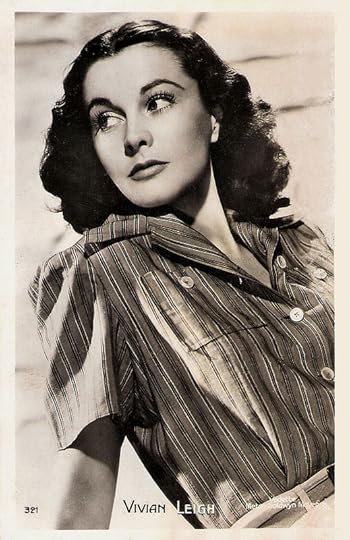
French postcard by Editions P.I., Paris, no. 321. Photo: Metro-Goldwyn-Mayer, 1950.
Fire Over England
Vivien Leigh was born Vivian Mary Hartley in Darjeeling, India, to Ernest Hartley, a British Officer in the Indian Cavalry, and Gertrude Robinson Yackje. In 1917, her father was relocated to Bangalore, while Vivian and her mother stayed in Ootacamund.
At age six, Vivian was sent to a convent school in England. In addition to taking the usual classes, Vivian studied violin, piano, cello, and ballet, and participated in school plays. A friend there was the future actress Maureen O'Sullivan, to whom she expressed her desire to become 'a great actress'.
In 1931 her father helped her enrol at the Royal Academy of Dramatic Art (RADA) in London. She met Herbert Leigh Holman, known as Leigh, a barrister thirteen years her senior. Despite his disapproval of ‘theatrical people’, they were married in 1932, and upon their marriage she terminated her studies at RADA.
In 1933, she gave birth to a daughter, Suzanne, but felt stifled by her domestic life. Her friends suggested her for a small part in Things Are Looking Up (Albert de Courville, 1935), which marked her film debut.
She engaged an agent, John Gliddon, who recommended her to film director and producer Alexander Korda, but he rejected her as lacking potential. Cast in the play The Mask of Virtue in 1935, Vivien Leigh received excellent reviews followed by interviews and newspaper articles. Korda, who attended her opening-night performance, admitted his error and signed her to a film contract.
Laurence Olivier saw Leigh in The Mask of Virtue, and a friendship developed after he congratulated her on her performance. While playing lovers in the film Fire Over England (William K. Howard, 1937), Olivier and Leigh developed a strong attraction, and after filming was completed, they began an affair. Olivier was at that time married to the actress Jill Esmond.
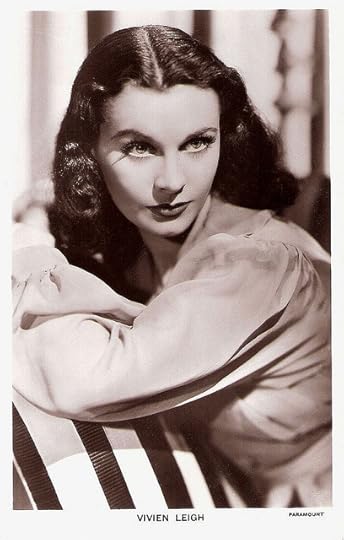
British postcard in the Picturegoer series, London, no. 1124b. Photo: Paramount.

German postcard by Kunst und Bild, Berlin, no. A 747. Photo: Metro-Goldwyn-Mayer.
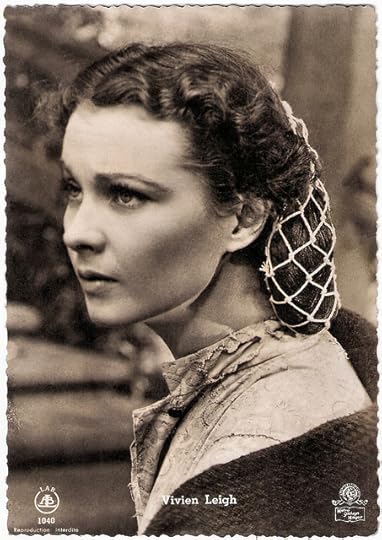
Belgian postcard by Les Editions d'Art L.A.B., Bruxelles (Brussels), no. 1040. Photo: MGM (Metro-Goldwyn-Mayer). Publicity still for Gone With The Wind (1939). This postcard was given to us by Gill4kleuren.
Fire Over Atlanta
Vivien Leigh played Ophelia to Olivier's Hamlet in an Old Vic Theatre production. They began living together, as their respective spouses had each refused to divorce. Leigh appeared with Conrad Veidt in the spy thriller Dark Journey (Victor Saville, 1937), and with Robert Taylor and Maureen O'Sullivan in A Yank at Oxford (Jack Conway, 1938). During production of the latter she developed a reputation for being difficult and unreasonable, and Korda instructed her agent to warn her.
Her next role was in St. Martin's Lane/Sidewalks of London (Tim Whelan, 1938) with Charles Laughton and Rex Harrison . Laurence Olivier travelled to Hollywood to play Heathcliff in Samuel Goldwyn's production of Wuthering Heights (William Wyler, 1939), leaving Vivien Leigh in London. She was offered the secondary role of Isabella, but she refused it, saying she would only play Cathy, a role already assigned to Merle Oberon .
Leigh's American agent was the London representative of the Myron Selznick Agency, and in 1938, she asked that her name be placed in consideration for the role of Scarlett O'Hara in David O. Selznick's (Myron’s brother) production of Gone with the Wind (1939, Victor Fleming) an epic adaptation of the bestseller by Margaret Mitchell. David O. Selznick watched her films, and from that time she became a serious contender for the part. Leigh travelled to Los Angeles, ostensibly to be with Olivier.
When Myron Selznick, who also represented Olivier, met Leigh, he felt that she possessed the qualities his brother was searching for. Myron took Leigh and Olivier to the set where the burning of the Atlanta Depot scene was being filmed, and introduced Leigh. The following day, Leigh read a scene for Selznick, who organised a screen test and wrote to his wife, "She's the Scarlett dark horse and looks damn good. Not for anyone's ear but your own: it's narrowed down to Paulette Goddard, Jean Arthur, Joan Bennett and Vivien Leigh".
Filming proved difficult for Leigh; director George Cukor was dismissed and replaced by Victor Fleming, with whom Leigh frequently quarrelled. Her role opposite Clark Gable brought Leigh immediate attention and fame. Among the ten Academy Awards won by Gone with the Wind was a Best Actress award for Leigh, who also won a New York Film Critics Circle Award for Best Actress.
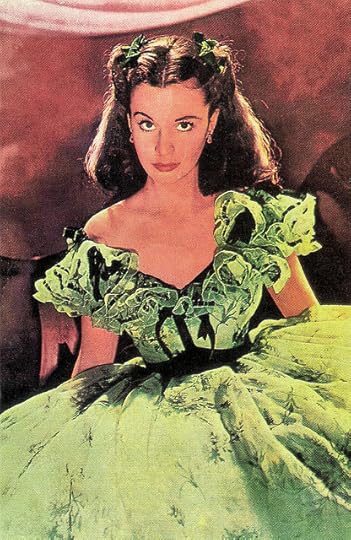
Romanian postcard by Casa Filmului Acin. Photo: MGM. Publicity still for Gone with the Wind (1939).
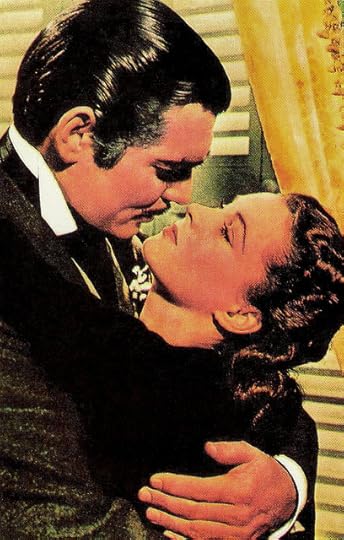
Romanian postcard by Casa Filmului Acin. Photo: MGM. Publicity still for Gone with the Wind (1939) with Clark Gable.
Adulterous Nature
In 1940, Laurence Olivier and Vivien Leigh were married. Leigh hoped to star with her husband and made a screen-test for Rebecca (Alfred Hitchcock, 1940). Selznick noted that she didn't seem right as to sincerity or age or innocence, and he subsequently cast Joan Fontaine. He also refused to allow her to join Olivier in Pride and Prejudice (Robert Z. Leonard, 1940), and Greer Garson took the part Leigh had envisioned for herself.
Waterloo Bridge (Mervyn Leroy, 1940) was to have starred Olivier and Leigh; however, Selznick replaced Olivier with Robert Taylor, then at the peak of his success as one of Metro-Goldwyn-Mayer's most popular male stars. Leigh's top billing reflected her status in Hollywood, and the film proved to be popular with audiences and critics.
She and Olivier mounted a stage production of Romeo and Juliet for Broadway. The New York press publicized the adulterous nature that had marked the beginning of Olivier and Leigh's relationship, and questioned their ethics in not returning to England to help with the war effort; and the critics were hostile in their assessment of the production. The couple had invested almost their entire savings into the project, and its failure was a financial disaster for them.
Next they filmed That Hamilton Woman (Alexander Korda, 1941) with Olivier as Horatio Nelson and Leigh as Emma Hamilton. The film was popular in the United States and an outstanding success in the Soviet Union. The Oliviers returned to England, and Leigh toured through North Africa in 1943, performing for troops before falling ill with a persistent cough and fevers. In 1944 she was diagnosed as having tuberculosis in her left lung. But after spending several weeks in hospital, she appeared to be cured.
When she suffered a miscarriage, she fell into a deep depression. This was the first of many major breakdowns related to bipolar disorder. She was well enough to resume acting in 1946, in a successful London production of Thornton Wilder's The Skin of Our Teeth, but her films of this period, Caesar and Cleopatra (Gabriel Pascal, 1945) and Anna Karenina (Julien Duvivier, 1948), were not great successes.
In 1947 Olivier was knighted, and Vivien Leigh accompanied him to Buckingham Palace for the investiture. She became Lady Olivier, and after their divorce, per the style granted the divorced wife of a knight, she became, socially, Vivien, Lady Olivier.
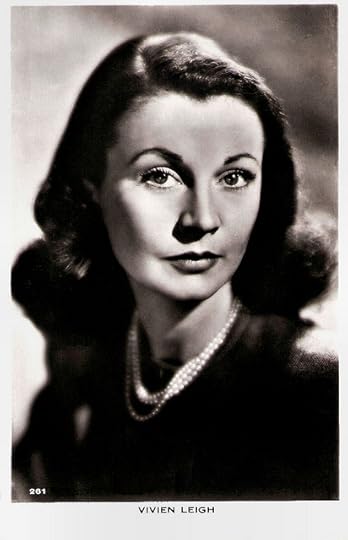
British postcard by Real Photograph, no. 261.
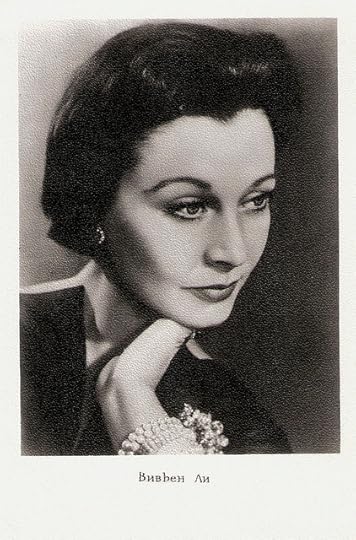
Russian postcard by Izdanije Byuro Propogandy Sovietskogo Kinoiskusstva, no. 8.(This postcard was printed in an edition of 100.000 cards. The price was 75 kop.).
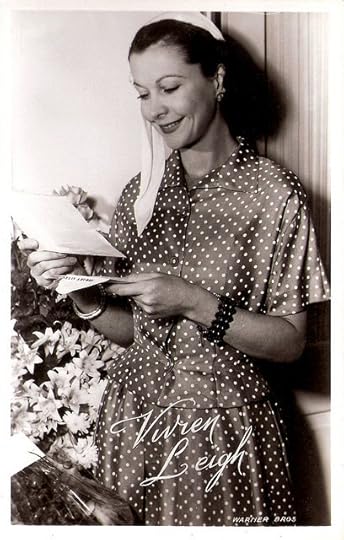
Dutch postcard, no. AX 283. (Foto-archief Film en Toneel) Photo: Warner Bros.
Romantic, Emotionally Fragile, and Tragic
Vivien Leigh played the role of Blanche DuBois in the West End stage production of Tennessee Williams's A Streetcar Named Desire. Like Blanche, Leigh was romantic, emotionally fragile, and tragic. After a run of 326 performances, she was also engaged for the film version opposite Marlon Brando. The film version of A Streetcar Named Desire (Elia Kazan, 1952) had glowing reviews, and she won a second Academy Award for Best Actress, a BAFTA Award and a New York Film Critics Circle Award for Best Actress.
In 1953, Leigh travelled to Ceylon to film Elephant Walk with Peter Finch. Shortly after filming commenced, she suffered a breakdown, and Paramount Pictures replaced her with Elizabeth Taylor. Olivier returned her to their home in England, where between periods of incoherence, Leigh told him that she had been having an affair with Finch. She gradually recovered over a period of several months.
Noël Coward was enjoying success with the play South Sea Bubble, with Leigh in the lead role, but she became pregnant and withdrew from the production. Several weeks later, she miscarried and entered a period of depression that lasted for months.
In 1960, she and Olivier divorced, and Olivier married the actress Joan Plowright. Vivien’s new partner Jack Merivale proved to be a stabilizing influence for her. Though she was still beset by bouts of depression, she continued to work in the theatre and in 1963 won a Tony Award for Best Actress in a Musical for her role in Tovarich.
She also appeared in the films The Roman Spring of Mrs. Stone (1961, José Quintero) opposite Warren Beatty, and in the all-star Ship of Fools (1965, Stanley Kramer).
After many long years of battling manic depression and several outbreaks of tuberculosis, Vivien Leigh's body gave out. She died in London in 1967.
Vivien Leigh screentests for Gone with the Wind. Source: VivienLeighCom (YouTube).
Vivien Leigh and Robert Taylor dance the farewell waltz in Waterloo Bridge (1940). Source: TheEagle54 (YouTube).
Trailer of A Streetcar Named Desire (1951). Source: British Film Institute (YouTube).
Sources: Brian McFarlane (Encyclopedia of British Film), Leigh Milla (Vivien-Leigh.com), Robert Ortiz (Find A Grave), Wikipedia, and .

French postcard by Editions P.I., Paris, no. 321. Photo: Metro-Goldwyn-Mayer, 1950.
Fire Over England
Vivien Leigh was born Vivian Mary Hartley in Darjeeling, India, to Ernest Hartley, a British Officer in the Indian Cavalry, and Gertrude Robinson Yackje. In 1917, her father was relocated to Bangalore, while Vivian and her mother stayed in Ootacamund.
At age six, Vivian was sent to a convent school in England. In addition to taking the usual classes, Vivian studied violin, piano, cello, and ballet, and participated in school plays. A friend there was the future actress Maureen O'Sullivan, to whom she expressed her desire to become 'a great actress'.
In 1931 her father helped her enrol at the Royal Academy of Dramatic Art (RADA) in London. She met Herbert Leigh Holman, known as Leigh, a barrister thirteen years her senior. Despite his disapproval of ‘theatrical people’, they were married in 1932, and upon their marriage she terminated her studies at RADA.
In 1933, she gave birth to a daughter, Suzanne, but felt stifled by her domestic life. Her friends suggested her for a small part in Things Are Looking Up (Albert de Courville, 1935), which marked her film debut.
She engaged an agent, John Gliddon, who recommended her to film director and producer Alexander Korda, but he rejected her as lacking potential. Cast in the play The Mask of Virtue in 1935, Vivien Leigh received excellent reviews followed by interviews and newspaper articles. Korda, who attended her opening-night performance, admitted his error and signed her to a film contract.
Laurence Olivier saw Leigh in The Mask of Virtue, and a friendship developed after he congratulated her on her performance. While playing lovers in the film Fire Over England (William K. Howard, 1937), Olivier and Leigh developed a strong attraction, and after filming was completed, they began an affair. Olivier was at that time married to the actress Jill Esmond.

British postcard in the Picturegoer series, London, no. 1124b. Photo: Paramount.

German postcard by Kunst und Bild, Berlin, no. A 747. Photo: Metro-Goldwyn-Mayer.

Belgian postcard by Les Editions d'Art L.A.B., Bruxelles (Brussels), no. 1040. Photo: MGM (Metro-Goldwyn-Mayer). Publicity still for Gone With The Wind (1939). This postcard was given to us by Gill4kleuren.
Fire Over Atlanta
Vivien Leigh played Ophelia to Olivier's Hamlet in an Old Vic Theatre production. They began living together, as their respective spouses had each refused to divorce. Leigh appeared with Conrad Veidt in the spy thriller Dark Journey (Victor Saville, 1937), and with Robert Taylor and Maureen O'Sullivan in A Yank at Oxford (Jack Conway, 1938). During production of the latter she developed a reputation for being difficult and unreasonable, and Korda instructed her agent to warn her.
Her next role was in St. Martin's Lane/Sidewalks of London (Tim Whelan, 1938) with Charles Laughton and Rex Harrison . Laurence Olivier travelled to Hollywood to play Heathcliff in Samuel Goldwyn's production of Wuthering Heights (William Wyler, 1939), leaving Vivien Leigh in London. She was offered the secondary role of Isabella, but she refused it, saying she would only play Cathy, a role already assigned to Merle Oberon .
Leigh's American agent was the London representative of the Myron Selznick Agency, and in 1938, she asked that her name be placed in consideration for the role of Scarlett O'Hara in David O. Selznick's (Myron’s brother) production of Gone with the Wind (1939, Victor Fleming) an epic adaptation of the bestseller by Margaret Mitchell. David O. Selznick watched her films, and from that time she became a serious contender for the part. Leigh travelled to Los Angeles, ostensibly to be with Olivier.
When Myron Selznick, who also represented Olivier, met Leigh, he felt that she possessed the qualities his brother was searching for. Myron took Leigh and Olivier to the set where the burning of the Atlanta Depot scene was being filmed, and introduced Leigh. The following day, Leigh read a scene for Selznick, who organised a screen test and wrote to his wife, "She's the Scarlett dark horse and looks damn good. Not for anyone's ear but your own: it's narrowed down to Paulette Goddard, Jean Arthur, Joan Bennett and Vivien Leigh".
Filming proved difficult for Leigh; director George Cukor was dismissed and replaced by Victor Fleming, with whom Leigh frequently quarrelled. Her role opposite Clark Gable brought Leigh immediate attention and fame. Among the ten Academy Awards won by Gone with the Wind was a Best Actress award for Leigh, who also won a New York Film Critics Circle Award for Best Actress.

Romanian postcard by Casa Filmului Acin. Photo: MGM. Publicity still for Gone with the Wind (1939).

Romanian postcard by Casa Filmului Acin. Photo: MGM. Publicity still for Gone with the Wind (1939) with Clark Gable.
Adulterous Nature
In 1940, Laurence Olivier and Vivien Leigh were married. Leigh hoped to star with her husband and made a screen-test for Rebecca (Alfred Hitchcock, 1940). Selznick noted that she didn't seem right as to sincerity or age or innocence, and he subsequently cast Joan Fontaine. He also refused to allow her to join Olivier in Pride and Prejudice (Robert Z. Leonard, 1940), and Greer Garson took the part Leigh had envisioned for herself.
Waterloo Bridge (Mervyn Leroy, 1940) was to have starred Olivier and Leigh; however, Selznick replaced Olivier with Robert Taylor, then at the peak of his success as one of Metro-Goldwyn-Mayer's most popular male stars. Leigh's top billing reflected her status in Hollywood, and the film proved to be popular with audiences and critics.
She and Olivier mounted a stage production of Romeo and Juliet for Broadway. The New York press publicized the adulterous nature that had marked the beginning of Olivier and Leigh's relationship, and questioned their ethics in not returning to England to help with the war effort; and the critics were hostile in their assessment of the production. The couple had invested almost their entire savings into the project, and its failure was a financial disaster for them.
Next they filmed That Hamilton Woman (Alexander Korda, 1941) with Olivier as Horatio Nelson and Leigh as Emma Hamilton. The film was popular in the United States and an outstanding success in the Soviet Union. The Oliviers returned to England, and Leigh toured through North Africa in 1943, performing for troops before falling ill with a persistent cough and fevers. In 1944 she was diagnosed as having tuberculosis in her left lung. But after spending several weeks in hospital, she appeared to be cured.
When she suffered a miscarriage, she fell into a deep depression. This was the first of many major breakdowns related to bipolar disorder. She was well enough to resume acting in 1946, in a successful London production of Thornton Wilder's The Skin of Our Teeth, but her films of this period, Caesar and Cleopatra (Gabriel Pascal, 1945) and Anna Karenina (Julien Duvivier, 1948), were not great successes.
In 1947 Olivier was knighted, and Vivien Leigh accompanied him to Buckingham Palace for the investiture. She became Lady Olivier, and after their divorce, per the style granted the divorced wife of a knight, she became, socially, Vivien, Lady Olivier.

British postcard by Real Photograph, no. 261.

Russian postcard by Izdanije Byuro Propogandy Sovietskogo Kinoiskusstva, no. 8.(This postcard was printed in an edition of 100.000 cards. The price was 75 kop.).

Dutch postcard, no. AX 283. (Foto-archief Film en Toneel) Photo: Warner Bros.
Romantic, Emotionally Fragile, and Tragic
Vivien Leigh played the role of Blanche DuBois in the West End stage production of Tennessee Williams's A Streetcar Named Desire. Like Blanche, Leigh was romantic, emotionally fragile, and tragic. After a run of 326 performances, she was also engaged for the film version opposite Marlon Brando. The film version of A Streetcar Named Desire (Elia Kazan, 1952) had glowing reviews, and she won a second Academy Award for Best Actress, a BAFTA Award and a New York Film Critics Circle Award for Best Actress.
In 1953, Leigh travelled to Ceylon to film Elephant Walk with Peter Finch. Shortly after filming commenced, she suffered a breakdown, and Paramount Pictures replaced her with Elizabeth Taylor. Olivier returned her to their home in England, where between periods of incoherence, Leigh told him that she had been having an affair with Finch. She gradually recovered over a period of several months.
Noël Coward was enjoying success with the play South Sea Bubble, with Leigh in the lead role, but she became pregnant and withdrew from the production. Several weeks later, she miscarried and entered a period of depression that lasted for months.
In 1960, she and Olivier divorced, and Olivier married the actress Joan Plowright. Vivien’s new partner Jack Merivale proved to be a stabilizing influence for her. Though she was still beset by bouts of depression, she continued to work in the theatre and in 1963 won a Tony Award for Best Actress in a Musical for her role in Tovarich.
She also appeared in the films The Roman Spring of Mrs. Stone (1961, José Quintero) opposite Warren Beatty, and in the all-star Ship of Fools (1965, Stanley Kramer).
After many long years of battling manic depression and several outbreaks of tuberculosis, Vivien Leigh's body gave out. She died in London in 1967.
Vivien Leigh screentests for Gone with the Wind. Source: VivienLeighCom (YouTube).
Vivien Leigh and Robert Taylor dance the farewell waltz in Waterloo Bridge (1940). Source: TheEagle54 (YouTube).
Trailer of A Streetcar Named Desire (1951). Source: British Film Institute (YouTube).
Sources: Brian McFarlane (Encyclopedia of British Film), Leigh Milla (Vivien-Leigh.com), Robert Ortiz (Find A Grave), Wikipedia, and .
Published on February 16, 2014 23:00
February 15, 2014
Fritz Rasp
German film actor Fritz Rasp (1891–1976) appeared in 104 films between 1916 and 1976. He excelled in dark roles: villains, rapists, traitors. His most notable film parts were Der Schmale (The Thin Man) in Fritz Lang's Metropolis (1927), Meinert in Tagebuch einer Verlorenen/Diary of a Lost Girl (1929), and J. J. Peachum in Die 3-Groschen-Oper/The Threepenny Opera (1931).
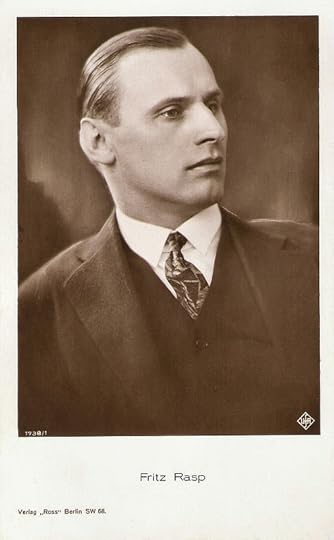
German postcard by Ross Verlag, no. 1738/1, 1927-1928. Photo: Ufa.
Typecast as the Villain
Fritz Heinrich Rasp was born in Bayreuth, Germany in 1891. He was the thirteenth child of the county surveyor Daniel Rasp and his wife Auguste Rasp-Grähl.
Fritz studied acting at the Theaterschule Otto Königin in München (Munich). Rasp debuted on the stage in 1909, as Amandus in Max Halbe's scandalous play Jugend (Youth) as the Münchner Schauspielhaus, and in 1914 he went on to work with the famous Max Reinhardt at the Deutschen Theater in Berlin.
In 1916 he made his film debut in the silent comedy Schuhpalast Pinkus/Shoe Palace Pinkus ( Ernst Lubitsch , 1916) starring Lubitsch himself and Ossi Oswalda . It was part of the Sally series of films featuring Lubitsch as Sally, a sharp young Berliner of Jewish heritage. After leaving school, the self-confident young man goes to work in a shoe shop and soon becomes a shoe tycoon.
Rasp also appeared in the fairy-tale Hans Trutz im Schlaraffenland/Hans Trutz in the land of plenty ( Paul Wegener , 1917). After his military service (1916-1918), he started to work for Max Reinhardt again.
His breakthrough as a screen actor came in 1922, when he played one of the main characters in Fred Sauer’s film adaptation of the play Jugend/Youth.
During the early 1920s he appeared in such silent films as Zwischen Abend und Morgen/Between Evening and Morning (Arthur Robison, 1923) starring Werner Krauss , the expressionist film Schatten – Eine nächtliche Halluzination/Warning Shadows (Arthur Robison, 1923) with Alexander Granach, and Ein Sommernachtstraum/Wood Love (Hans Neumann, 1925), an adaptation of William Shakespeare's A Midsummer Night's Dream starring Werner Krauss , Valeska Gert and Alexander Granach.
Filmportal.de : “While he was extremely versatile on stage, the screen actor Fritz Rasp – lean and tall with a narrow mouth and sunken eyes – is quickly typecast as the villain, a role which he often managed to subvert by adding layers of irony and psychological depth to his characters.”
A beautiful example is his part as Fredersen's spy Der Schmale (The Thin Man) in Fritz Lang's expressionist epic Metropolis (1927). The classic science-fiction film was written by Lang and his wife Thea von Harbou, and starred Brigitte Helm , Gustav Fröhlich , Alfred Abel (Joh Fredersen, the master of Metropolis) and Rudolf Klein-Rogge . Many of the scenes in which Rasp appears were part of the Metropolis footage long believed lost until their recovery in 2008.
His role in Metropolis was soon followed by supporting parts in other masterpieces of the Weimar cinema, such as Die Liebe der Jeanne Ney/The Love of Jeanne Ney (Georg Wilhelm Pabst, 1927), and Spione/Spies (Fritz Lang, 1928).
He also appeared in very popular entertainment films like Der letzte Walzer/The Last Waltz (Arthur Robison, 1927) starring Liane Haid and Willy Fritsch , and Schinderhannes/The Prince of Rogues (Kurt Bernhardt, 1928) starring Hans Stüwe .
In 1929 Rasp appeared again in two classic films. He played the rapist Meinert opposite American silent star Louise Brooks in Tagebuch einer Verlorenen/Diary of a Lost Girl (Georg Wilhelm Pabst, 1929). He reunited with Fritz Lang for the Science Fiction film Frau im Mond/Woman in the Moon (Fritz Lang, 1929) in which he played an evil American.
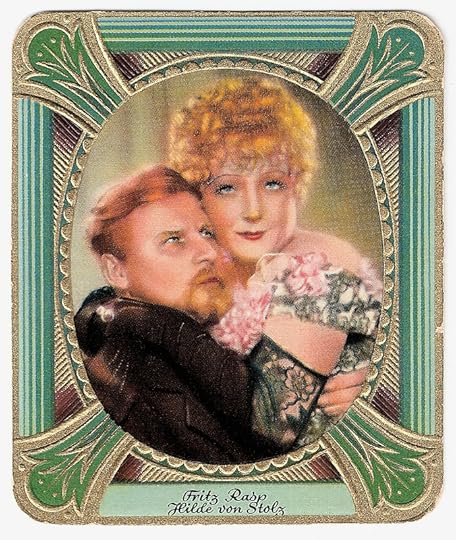
German collectors card. With Hilde von Stolz.
Nazi Era
Fritz Rasp started the sound era with more great films. He played the thief Grundeis in the children film classic Emil und die Detektive/Emil and the Detectives (Gerhard Lamprecht, 1931) based on the novel by Erich Kästner, who also contributed to the film's script, written by Billy (then: Billie) Wilder.
Another notable role was J. J. Peachum in the musical Die 3-Groschen-Oper/The Threepenny Opera (G. W. Pabst, 1931), loosely based on the musical theatre success by Bertolt Brecht and Kurt Weill.
He also appeared in popular films of the time like Der Zinker/The Squeaker (Martin Frič, Karel Lamač, 1931) with Lissi Arna , and Der Hexer/The Sorcerer (Martin Frič, Karel Lamač aka Carl Lamac, 1932) with Paul Richter , both German screen adaptations of Edgar Wallace thrillers.
In Paris, he played in the American German language drama Tropennächte/Tropical Nights (Leo Mittler, 1931) starring Dita Parlo . The film was one of five multi-language versions of the American film Dangerous Paradise (1930) made by Paramount at the Joinville Studios in Paris. These were made in the years following the introduction of sound film, before the practice of dubbing became widespread.
During the Nazi era he only got small roles in films like the comedy Onkel Bräsig/Uncle Bräsig (Erich Waschneck, 1936) and the mystery Der Hund von Baskerville/The Hound of the Baskervilles (Karel Lamač aka Carl Lamac, 1937), an adaptation of the Sherlock Holmes's story The Hound of the Baskervilles by Arthur Conan Doyle.
In 1943, he reunited with director Georg Wilhelm Pabst for the drama Paracelsus (G.W. Pabst, 1943) based on the life of Paracelsus ( Werner Krauss ).
After the war he first appeared in Eastern Germany in productions by the DEFA. He also performed on the stages of Berlin.
Later he was seen in West-German light entertainment films like the mystery Das schwarze Schaf /The Black Sheep (Helmut Ashley, 1960) starring Heinz Rühmann and based on the Father Brown stories by G.K. Chesterton.
Rasp also played in the popular Edgar Wallace adaptations of the 1960s, such as Der rote Kreis/The Crimson Circle (Jürgen Roland, 1960), Die seltsame Gräfin/The Strange Countess (Josef von Báky, 1961) and Das Rätsel der roten Orchidee/The Puzzle of the Red Orchid (Helmut Ashley, 1962) starring Christopher Lee.
In 1963 he was honoured for his work in the German cinema with the Filmband in Gold award. One of his last films was the sweet crime comedy Lina Braake (Bernhard Sinkel1975), in which Lina Carstens and he played revolting seniors who rob a bank.
Fritz Rasp died in 1976 in Gräfelfing, Germany. He was 85. His wife was Charlotte Petermann.
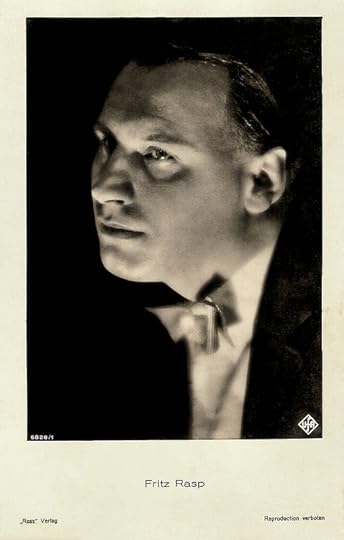
German postcard by Ross Verlag, no. 6828/1, 1931-1932. Photo: Ufa.
Sources: Filmportal.de, Wikipedia (German and English) and .

German postcard by Ross Verlag, no. 1738/1, 1927-1928. Photo: Ufa.
Typecast as the Villain
Fritz Heinrich Rasp was born in Bayreuth, Germany in 1891. He was the thirteenth child of the county surveyor Daniel Rasp and his wife Auguste Rasp-Grähl.
Fritz studied acting at the Theaterschule Otto Königin in München (Munich). Rasp debuted on the stage in 1909, as Amandus in Max Halbe's scandalous play Jugend (Youth) as the Münchner Schauspielhaus, and in 1914 he went on to work with the famous Max Reinhardt at the Deutschen Theater in Berlin.
In 1916 he made his film debut in the silent comedy Schuhpalast Pinkus/Shoe Palace Pinkus ( Ernst Lubitsch , 1916) starring Lubitsch himself and Ossi Oswalda . It was part of the Sally series of films featuring Lubitsch as Sally, a sharp young Berliner of Jewish heritage. After leaving school, the self-confident young man goes to work in a shoe shop and soon becomes a shoe tycoon.
Rasp also appeared in the fairy-tale Hans Trutz im Schlaraffenland/Hans Trutz in the land of plenty ( Paul Wegener , 1917). After his military service (1916-1918), he started to work for Max Reinhardt again.
His breakthrough as a screen actor came in 1922, when he played one of the main characters in Fred Sauer’s film adaptation of the play Jugend/Youth.
During the early 1920s he appeared in such silent films as Zwischen Abend und Morgen/Between Evening and Morning (Arthur Robison, 1923) starring Werner Krauss , the expressionist film Schatten – Eine nächtliche Halluzination/Warning Shadows (Arthur Robison, 1923) with Alexander Granach, and Ein Sommernachtstraum/Wood Love (Hans Neumann, 1925), an adaptation of William Shakespeare's A Midsummer Night's Dream starring Werner Krauss , Valeska Gert and Alexander Granach.
Filmportal.de : “While he was extremely versatile on stage, the screen actor Fritz Rasp – lean and tall with a narrow mouth and sunken eyes – is quickly typecast as the villain, a role which he often managed to subvert by adding layers of irony and psychological depth to his characters.”
A beautiful example is his part as Fredersen's spy Der Schmale (The Thin Man) in Fritz Lang's expressionist epic Metropolis (1927). The classic science-fiction film was written by Lang and his wife Thea von Harbou, and starred Brigitte Helm , Gustav Fröhlich , Alfred Abel (Joh Fredersen, the master of Metropolis) and Rudolf Klein-Rogge . Many of the scenes in which Rasp appears were part of the Metropolis footage long believed lost until their recovery in 2008.
His role in Metropolis was soon followed by supporting parts in other masterpieces of the Weimar cinema, such as Die Liebe der Jeanne Ney/The Love of Jeanne Ney (Georg Wilhelm Pabst, 1927), and Spione/Spies (Fritz Lang, 1928).
He also appeared in very popular entertainment films like Der letzte Walzer/The Last Waltz (Arthur Robison, 1927) starring Liane Haid and Willy Fritsch , and Schinderhannes/The Prince of Rogues (Kurt Bernhardt, 1928) starring Hans Stüwe .
In 1929 Rasp appeared again in two classic films. He played the rapist Meinert opposite American silent star Louise Brooks in Tagebuch einer Verlorenen/Diary of a Lost Girl (Georg Wilhelm Pabst, 1929). He reunited with Fritz Lang for the Science Fiction film Frau im Mond/Woman in the Moon (Fritz Lang, 1929) in which he played an evil American.

German collectors card. With Hilde von Stolz.
Nazi Era
Fritz Rasp started the sound era with more great films. He played the thief Grundeis in the children film classic Emil und die Detektive/Emil and the Detectives (Gerhard Lamprecht, 1931) based on the novel by Erich Kästner, who also contributed to the film's script, written by Billy (then: Billie) Wilder.
Another notable role was J. J. Peachum in the musical Die 3-Groschen-Oper/The Threepenny Opera (G. W. Pabst, 1931), loosely based on the musical theatre success by Bertolt Brecht and Kurt Weill.
He also appeared in popular films of the time like Der Zinker/The Squeaker (Martin Frič, Karel Lamač, 1931) with Lissi Arna , and Der Hexer/The Sorcerer (Martin Frič, Karel Lamač aka Carl Lamac, 1932) with Paul Richter , both German screen adaptations of Edgar Wallace thrillers.
In Paris, he played in the American German language drama Tropennächte/Tropical Nights (Leo Mittler, 1931) starring Dita Parlo . The film was one of five multi-language versions of the American film Dangerous Paradise (1930) made by Paramount at the Joinville Studios in Paris. These were made in the years following the introduction of sound film, before the practice of dubbing became widespread.
During the Nazi era he only got small roles in films like the comedy Onkel Bräsig/Uncle Bräsig (Erich Waschneck, 1936) and the mystery Der Hund von Baskerville/The Hound of the Baskervilles (Karel Lamač aka Carl Lamac, 1937), an adaptation of the Sherlock Holmes's story The Hound of the Baskervilles by Arthur Conan Doyle.
In 1943, he reunited with director Georg Wilhelm Pabst for the drama Paracelsus (G.W. Pabst, 1943) based on the life of Paracelsus ( Werner Krauss ).
After the war he first appeared in Eastern Germany in productions by the DEFA. He also performed on the stages of Berlin.
Later he was seen in West-German light entertainment films like the mystery Das schwarze Schaf /The Black Sheep (Helmut Ashley, 1960) starring Heinz Rühmann and based on the Father Brown stories by G.K. Chesterton.
Rasp also played in the popular Edgar Wallace adaptations of the 1960s, such as Der rote Kreis/The Crimson Circle (Jürgen Roland, 1960), Die seltsame Gräfin/The Strange Countess (Josef von Báky, 1961) and Das Rätsel der roten Orchidee/The Puzzle of the Red Orchid (Helmut Ashley, 1962) starring Christopher Lee.
In 1963 he was honoured for his work in the German cinema with the Filmband in Gold award. One of his last films was the sweet crime comedy Lina Braake (Bernhard Sinkel1975), in which Lina Carstens and he played revolting seniors who rob a bank.
Fritz Rasp died in 1976 in Gräfelfing, Germany. He was 85. His wife was Charlotte Petermann.

German postcard by Ross Verlag, no. 6828/1, 1931-1932. Photo: Ufa.
Sources: Filmportal.de, Wikipedia (German and English) and .
Published on February 15, 2014 23:00
February 14, 2014
Studio Lorelle
Lucien Lorelle (1894-1968) was one of the great photographers of the early twentieth century. In his Studio Lorelle, he portrayed all the great French artists of his time.

Brigitte Helm . French postcard by Cine-Europe, no. 339. Photo: Studio Lorelle. Publicity still for L'Argent/The Money (Marcel L'Herbier, 1928).

Brigitte Helm . French postcard by J.R.P.R., Paris, no. 338. Photo: Studio Lorelle, Paris. Publicity still for L'Argent/The Money (Marcel L'Herbier, 1928).
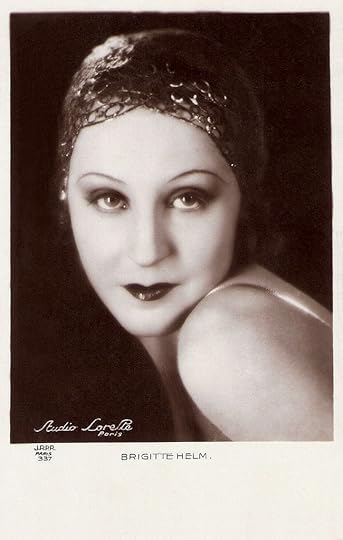
Brigitte Helm . French postcard by J.R.P.R., Paris, no. 337. Photo: Studio Lorelle, Paris. Publicity still for L'Argent/The Money (Marcel L'Herbier, 1928).
Sought After Portraitist
Lucien Lorelle was born in Paris, France in 1894. He was a volunteer in the French infantry and aviation during World War I and later received the Croix de Guerre and the Légion d’Honneur for his bravery.
In 1920 he started to work as a photographer at the famous portrait Studio G.L. Manuel Frères.
In 1927, Lucien founded with his brother-in-law the Studio Lorelle, which focused entirely on studio portraits. Many young photographers went to work and study photography here, including Czech photographer Jaroslav Rössler, German photographer Erna Wagner-Hehmke and Rose Nadau.
Lorelle soon became a sought after portraitist. To his studio came famous artists like Jean Cocteau and Tamara de Lempicka, and international film stars like Louise Brooks , Jean Murat , Käthe von Nagy , Marie Glory and Brigitte Helm .
In 1935 he sold the Studio Lorelle and founded the Studio Lucien Lorelle. This studio did advertising campaigns for Galeries Lafayette (with Cassandre), Perrier, Philips, Cinzano, Chanel, Shell etc.
Lorelle had already done a postcard campaign with film stars for Campari at Studio Lorelle. Campari was a client which he had taken with him from Studio G.T. Manuel Frères.
Though Lorelle dreamt of becoming a painter, photography monopolized his time, and the paintings he did complete, he systematically destroyed.

Jean Murat . French postcard. Photo: Studio Lorelle, Paris.
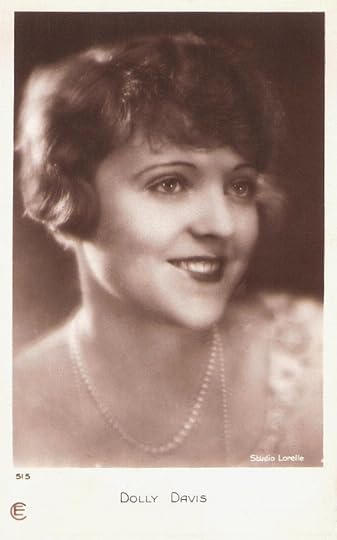
Dolly Davis . French postcard by Editions Cinemagazine, no. 515. Photo: Studio Lorelle.
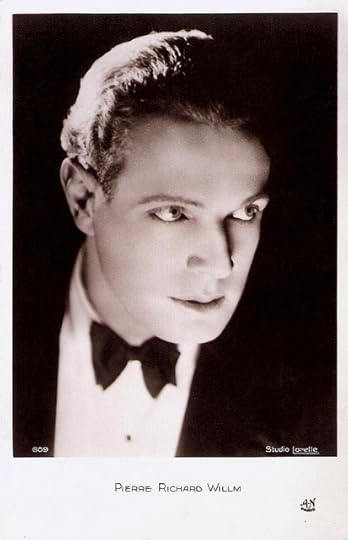
Pierre Richard Willm . French postcard by A.N., Paris, no. 609. Photo: Studio Lorelle.
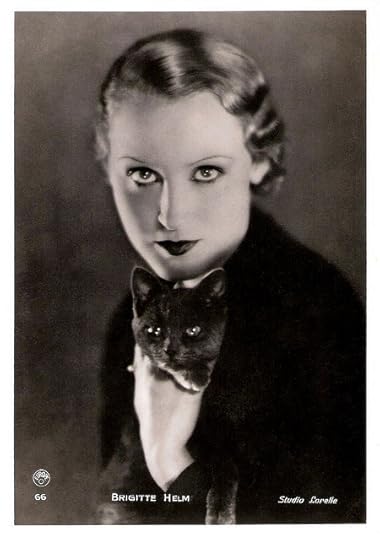
Brigitte Helm . French postcard in the Europe series, no. 66, ca. 1932. Photo: Studio Lorelle.

René Lefèvre . French postcard by Editions A.N., Paris, no. 770. Photo: Studio Lorelle / Film Pathé-Natan.
Colour
In 1946, Lucien Lorelle was one of the 15 founders of the Groupe des XV, an association which promoted photography as art and drew attention to the preservation of French photographic heritage.
The group (also including Robert Doisneau, Willy Ronis and René Jacques) organized from 1946 to 1957 annual exhibitions in various galleries.
Lorelle continued to portray all the famous French artists of his time including Annabella , Martine Carol , Danielle Darrieux , Gérard Philipe , Jean Marais , Michel Simon and Jean Gabin .
In 1949 Lucien Lorelle published La Photographie publicitaire, co-written with Donald Langelaan. He also wrote books like Le Portrait photographique (1950) and Le Livre de la couleur directe (1951). His books were translated in many languages.
In 1952, he founded Central Color, a professional colour photography laboratory, involved with various international projects, including the Tour de France, L’Oréal and Giorgio Armani.
In 1957 he stopped with the Studio Lucien Lorelle and focused on writing. He was the author of many surreal photographic works and literary tributes combining text, drawings and photographs. He also was devoted to teaching photography. His other hobbies included painting, writing and poetry.
In the 1960s Lucien Lorelle handed over the presidency of Central Color to his daughter Françoise Gallois, who deceased in 2003. Lucien Lorelle himself died in 1968.

Pauley . French postcard for Campari. Photo: Studio Lorelle. Caption: "Dès que je bois du Campari, Oh! mes amis, quel appetit!" (Ever since I drink Campari, oh my friends, what an appetite!).
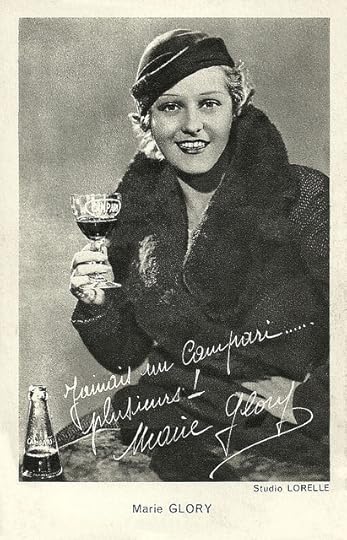
Marie Glory . French postcard for Campari. Photo: Studio Lorelle. Caption: "J'aimais un Campari... plusieurs!" (I would like 'Campari'... several!)

André Roanne . French postcard for Campari. Photo: Studio Lorelle. Caption: "Qui dit Campari, dit appétit!" (Who says Campari, says appetite!)
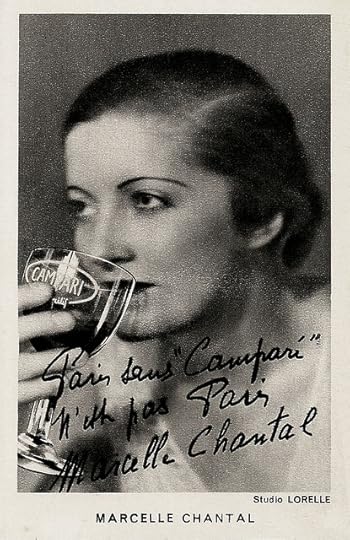
Marcelle Chantal . French postcard for Campari. Photo: Studio Lorelle. Caption: "Paris sans Campari, n'est pas Campari." (Paris without Campari isn't Paris.)
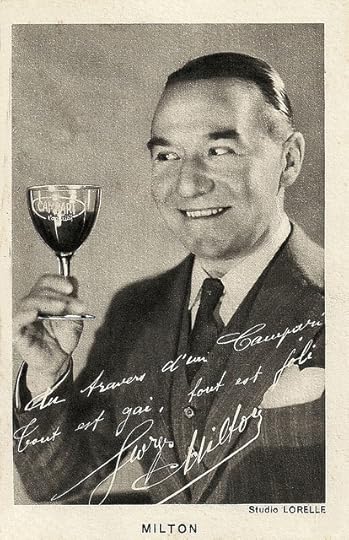
Georges Milton . French postcard for Campari. Photo: Studio Lorelle. Caption: "Au travers d'un Campari, Tout est gai, tout est joli." (With a Campari, all is gay, all is nice).
This is the sixth post in a series on film star photographers. Earlier posts were on the Reutlinger Studio in Paris, Italian star photographer Attilio Badodi, the German photographer Ernst Schneider, Dutch photo artist Godfried de Groot and on Milanese photographers Arturo Varischi and Giovanni Artico.
Sources: LucienLorelle.com, Melissa Demiguel (Bella Online), and Wikipedia (French). See also: dovima_is_devine_II's set of Lorelle's surrealistic photos on Flickr and see an interesting surrealistic impression with two photographs of Brigitte Helm from L'Argent at Bits & Bites.

Brigitte Helm . French postcard by Cine-Europe, no. 339. Photo: Studio Lorelle. Publicity still for L'Argent/The Money (Marcel L'Herbier, 1928).

Brigitte Helm . French postcard by J.R.P.R., Paris, no. 338. Photo: Studio Lorelle, Paris. Publicity still for L'Argent/The Money (Marcel L'Herbier, 1928).

Brigitte Helm . French postcard by J.R.P.R., Paris, no. 337. Photo: Studio Lorelle, Paris. Publicity still for L'Argent/The Money (Marcel L'Herbier, 1928).
Sought After Portraitist
Lucien Lorelle was born in Paris, France in 1894. He was a volunteer in the French infantry and aviation during World War I and later received the Croix de Guerre and the Légion d’Honneur for his bravery.
In 1920 he started to work as a photographer at the famous portrait Studio G.L. Manuel Frères.
In 1927, Lucien founded with his brother-in-law the Studio Lorelle, which focused entirely on studio portraits. Many young photographers went to work and study photography here, including Czech photographer Jaroslav Rössler, German photographer Erna Wagner-Hehmke and Rose Nadau.
Lorelle soon became a sought after portraitist. To his studio came famous artists like Jean Cocteau and Tamara de Lempicka, and international film stars like Louise Brooks , Jean Murat , Käthe von Nagy , Marie Glory and Brigitte Helm .
In 1935 he sold the Studio Lorelle and founded the Studio Lucien Lorelle. This studio did advertising campaigns for Galeries Lafayette (with Cassandre), Perrier, Philips, Cinzano, Chanel, Shell etc.
Lorelle had already done a postcard campaign with film stars for Campari at Studio Lorelle. Campari was a client which he had taken with him from Studio G.T. Manuel Frères.
Though Lorelle dreamt of becoming a painter, photography monopolized his time, and the paintings he did complete, he systematically destroyed.

Jean Murat . French postcard. Photo: Studio Lorelle, Paris.

Dolly Davis . French postcard by Editions Cinemagazine, no. 515. Photo: Studio Lorelle.

Pierre Richard Willm . French postcard by A.N., Paris, no. 609. Photo: Studio Lorelle.

Brigitte Helm . French postcard in the Europe series, no. 66, ca. 1932. Photo: Studio Lorelle.

René Lefèvre . French postcard by Editions A.N., Paris, no. 770. Photo: Studio Lorelle / Film Pathé-Natan.
Colour
In 1946, Lucien Lorelle was one of the 15 founders of the Groupe des XV, an association which promoted photography as art and drew attention to the preservation of French photographic heritage.
The group (also including Robert Doisneau, Willy Ronis and René Jacques) organized from 1946 to 1957 annual exhibitions in various galleries.
Lorelle continued to portray all the famous French artists of his time including Annabella , Martine Carol , Danielle Darrieux , Gérard Philipe , Jean Marais , Michel Simon and Jean Gabin .
In 1949 Lucien Lorelle published La Photographie publicitaire, co-written with Donald Langelaan. He also wrote books like Le Portrait photographique (1950) and Le Livre de la couleur directe (1951). His books were translated in many languages.
In 1952, he founded Central Color, a professional colour photography laboratory, involved with various international projects, including the Tour de France, L’Oréal and Giorgio Armani.
In 1957 he stopped with the Studio Lucien Lorelle and focused on writing. He was the author of many surreal photographic works and literary tributes combining text, drawings and photographs. He also was devoted to teaching photography. His other hobbies included painting, writing and poetry.
In the 1960s Lucien Lorelle handed over the presidency of Central Color to his daughter Françoise Gallois, who deceased in 2003. Lucien Lorelle himself died in 1968.

Pauley . French postcard for Campari. Photo: Studio Lorelle. Caption: "Dès que je bois du Campari, Oh! mes amis, quel appetit!" (Ever since I drink Campari, oh my friends, what an appetite!).

Marie Glory . French postcard for Campari. Photo: Studio Lorelle. Caption: "J'aimais un Campari... plusieurs!" (I would like 'Campari'... several!)

André Roanne . French postcard for Campari. Photo: Studio Lorelle. Caption: "Qui dit Campari, dit appétit!" (Who says Campari, says appetite!)

Marcelle Chantal . French postcard for Campari. Photo: Studio Lorelle. Caption: "Paris sans Campari, n'est pas Campari." (Paris without Campari isn't Paris.)

Georges Milton . French postcard for Campari. Photo: Studio Lorelle. Caption: "Au travers d'un Campari, Tout est gai, tout est joli." (With a Campari, all is gay, all is nice).
This is the sixth post in a series on film star photographers. Earlier posts were on the Reutlinger Studio in Paris, Italian star photographer Attilio Badodi, the German photographer Ernst Schneider, Dutch photo artist Godfried de Groot and on Milanese photographers Arturo Varischi and Giovanni Artico.
Sources: LucienLorelle.com, Melissa Demiguel (Bella Online), and Wikipedia (French). See also: dovima_is_devine_II's set of Lorelle's surrealistic photos on Flickr and see an interesting surrealistic impression with two photographs of Brigitte Helm from L'Argent at Bits & Bites.
Published on February 14, 2014 23:00
February 13, 2014
Martine Carol
One of the French cinema's most beautiful women was Martine Carol (1920–1967). During the early 1950s the French sex symbol was a top box office draw as an elegant blonde seductress in many films. Her private life was filled with turmoil including a suicide attempt, drug abuse, a kidnapping, and a mysterious death.

Yugoslavian postcard by Studio Sombor, no. 314.
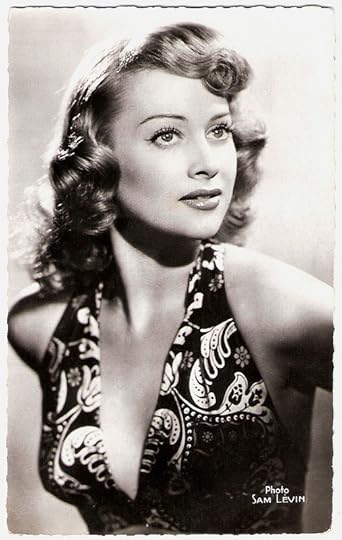
French postcard by Editions du Globe (E.D.U.G.), Paris, no. 132. Photo: Sam Lévin.
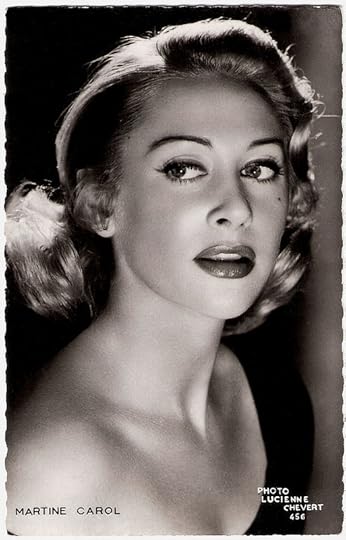
French postcard by Editions P.I., no. 210 H. Photo: Lucienne Chevert, no. 456.
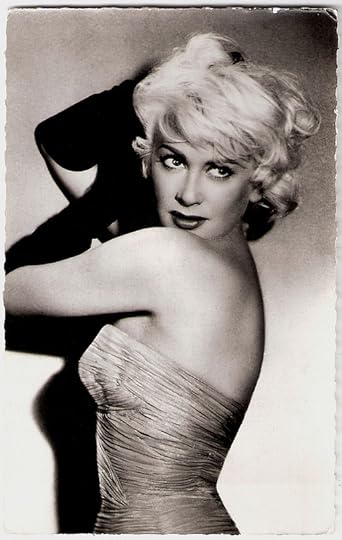
French postcard by Editions du Globe, Paris, no. 690. Photo: Sam Lévin.

Vintage card. Photo: still for Lucrèce Borgia/Lucretia Borgia (Christian-Jaque, 1953).
Anti-Semitic Propaganda
Martine Carol was born in 1920 as Maryse Louise Mourer in Saint-Mandé, Val-de-Marne, France.
A chance meeting with comedian André Luguet steered her toward a career in the theatre. Trained by René Simon, she made her 1940 stage debut with Phèdre, billed as Maryse Arley.
She subsequently caught the eye of film director Henri-Georges Clouzot who hired her for his film Le Chat/The Cat, based on the novel by Colette, but the project was scrapped.
She made her first film appearance in the anti-Semitic propaganda film Les Corrupteurs (Pierre Ramelot, 1941), but she first attracted attention in La ferme aux loups/Wolf Farm (Richard Pottier, 1943), which takes advantage of her photogenic beauty and ease in front of the camera despite a limited acting ability.
Throughout the 1940s she was a pin-up goddess and support actress in films like the comedy Voyage surprise (Pierre Prévert, 1947) and Les amants de Vérone/The Lovers of Verona (André Cayatte, 1949).
She also appeared on the stage of the Theatre of the Renaissance. In 1947 a torrid affair with actor Georges Marchal , who was married to actress Dany Robin at the time, ended disastrously and she attempted suicide by taking an alcohol/drug overdose and throwing herself off a bridge into the Seine River. She was saved by a taxi driver who accompanied her there. Ironically, the unhappy details surrounding her suicide attempt renewed the fascination audiences had with Martine up until that time.
She was also kidnapped by gangster Pierre Loutrel (aka ‘Crazy Pete’), albeit briefly and received roses the next day as an apology.
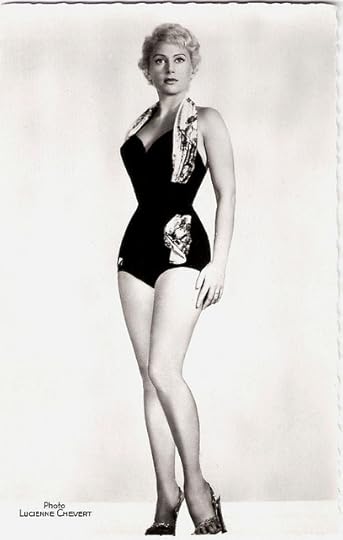
French postcard by Editions du Globe (E.D.U.G.), Paris, no. 357. Photo: Lucienne Chevert.
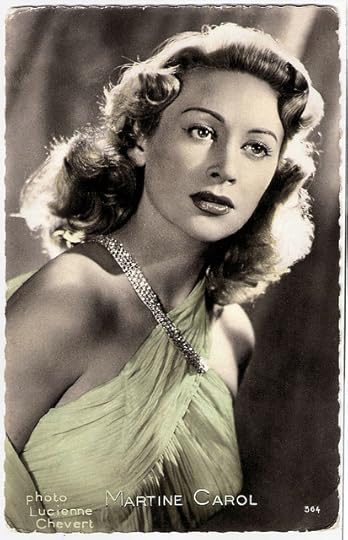
French postcard by Editions P.I., Paris, no. 364. Photo: Lucienne Chevert.
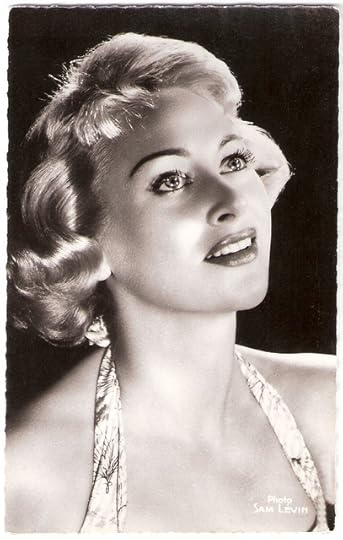
French postcard by Editions du Globe (E.D.U.G.), Paris, no. 564. Photo: Sam Lévin.
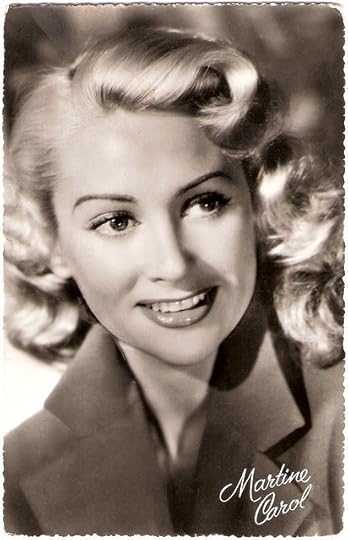
Dutch postcard by DRC, no. F192-657, posted in 1958.
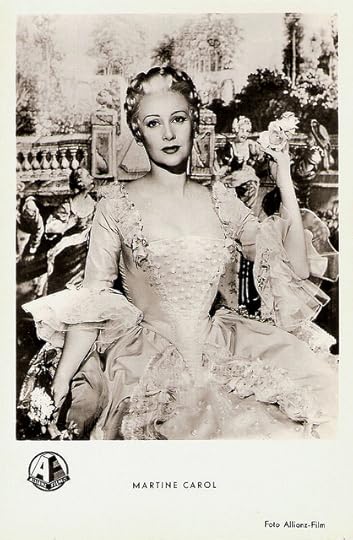
German postcard by Kunst un Bild. Berlin, no. A 1146. Photo: Allianz-Film. Publicity still for Madame du Barry/Madame Dubarry (Christian Jacque, 1954).
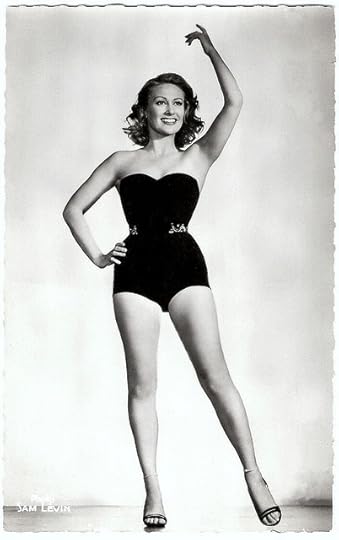
French postcard by Editions du Globe, Paris, no. 432. Photo: Sam Lévin.
Taunting, Kittenish Sexuality
In 1950 Martine Carol scored her first huge film success with the French Revolution epic Caroline Cherie/Dear Caroline (Richard Pottier, 1950) - no doubt prompted by her semi-nude scenes and taunting, kittenish sexuality - and she was off and running at the box office.
Her film romps were typically done tastefully with an erotic twinge of innocence and gentle sexuality plus an occasional bubble bath thrown in as male bait. She continued spectacularly with an array of costumed teasers such as Adorables créatures/Adorable Creatures (1952), Lucrèce Borgia/Sins of the Borgias (1953), Madame du Barry (1954), and Nana (1954), all guided and directed by second husband Christian-Jacque, whom she married in 1954.
Martine later divorced the director due to professional conflicts and long separations. She also starred in Belles de Nuit/ Beauties of the Night (René Clair, 1952) opposite Gérard Philipe , and in the last comedy directed by Preston Sturges, Les Carnets du Major Thompson/The Diary of Major Thompson (1955), based on the best-seller by Pierre Daninos.
One of her last major roles was as the title character in Lola Montés (Max Ophüls, 1955), the tragic and true story of the great adventurer, circus attraction and lover of various important men.
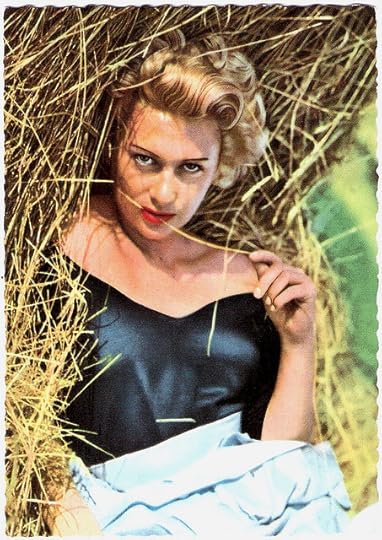
German postcard by Universum-Film Aktiengesellschaft, Berlin-Tempelhof, no. CK-2. Retail price: 30 Pfg. Photo: Gérard Décaux/Ufa.
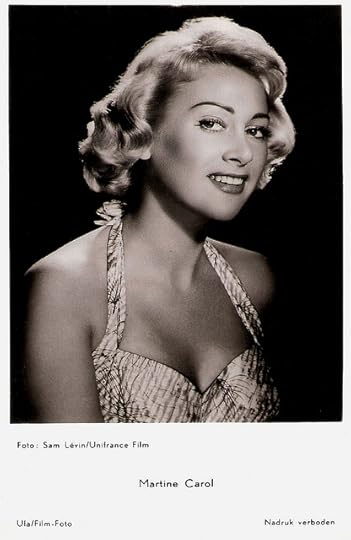
Dutch postcard by Gebr. Spanjersberg N.V., Rotterdam (Dutch licency holder for Ufa/Film-Foto, Berlin-Tempelhof), no. 3611. Photo: Sam Lévin / Unifrance Film.
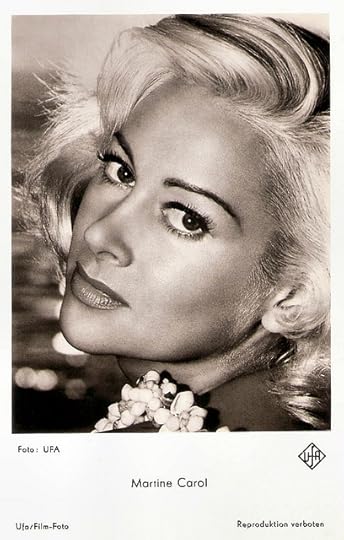
German postcard by Ufa, Berlin-Tempelhof, no. FK 4064. Retail price: 25 Pfg. Photo: Ufa. Publicity still for The Stowaway (Ralph Habib, Lee Robinson, 1958).
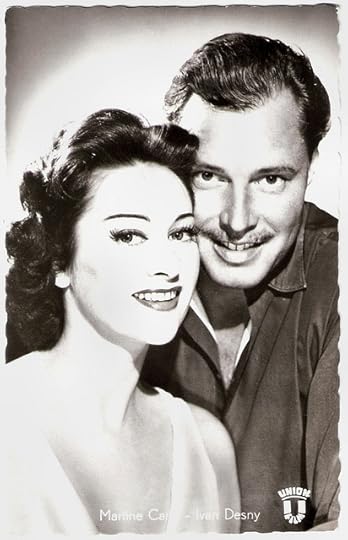
German postcard by Kolibri-Verlag G.m.b.H. Minden/Westf., no. 1719. Photo: Gamma / Union / Vogelmann. Publicity still for Lola Montez (Max Ophüls, 1955) with Ivan Desny .
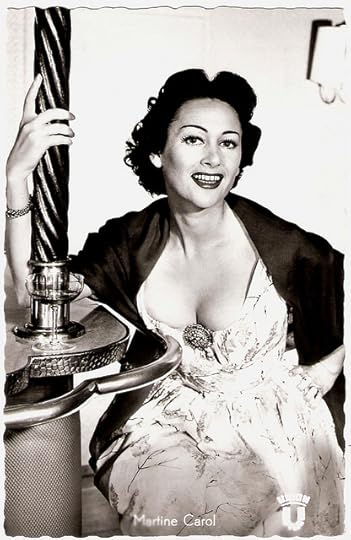
German postcard by Kolibri-Verlag, Minden-Westf., no. 1723. Photo: Gamma / Union / Vogelmann. Publicity still for Lola Montès (Max Ophüls, 1955).
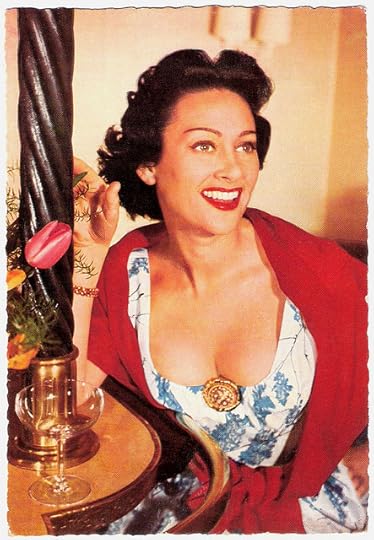
German postcard by WS-Druck, Wanne-Eickel, no. F 5. Photo: Collignon.
Severe Decline
By the mid 1950s, Brigitte Bardot had replaced Martine Carol as the national Sex Siren, and the voluptuous blonde's career went into a severe decline.
Although such mature roles as Empress Josephine in Austerlitz/The Battle of Austerlitz (Abel Gance, 1960) and Contessa Vitelleschi in Vanina Vanini (Roberto Rossellini, 1961) followed, nothing revived audience interest.
Depressed, she turned alarmingly reclusive while a third marriage to French doctor Andre Rouveix also soured by 1962. Problems with substance abuse and a severe accident in the 1960s also curtailed her career dramatically.
Her last film was Hell Is Empty (John Ainsworth, Bernard Knowles, 1963). Production was briefly halted due to her illness. This is why the film has two directors. Although filmed in 1963 it was not released until 1967. (By the time of the release of the film, two of the leading ladies, Patricia Viterbo and Martine, were already dead.)
Martine Carol’s last marriage to fourth husband Mike Eland, an English businessman and friend of first husband Steve Crane, seemed hopeful, but in 1967, she died of cardiac arrest at age 46 in the bathroom of a hotel in Monaco. Her husband discovered her.
Newspapers hinted at a possible drug overdose but nothing was ever proven. She was initially buried in the Père Lachaise Cemetery of Paris. But her grave was violated (some media reported that she had been interred with her jewels). Martine Carol was then buried in the Grand Jas Cemetery of Cannes.
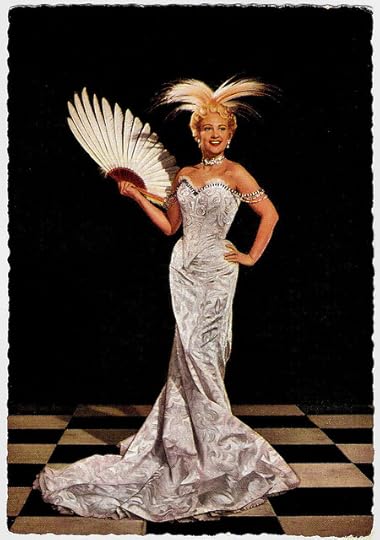
German postcard by Ufa, Berlin-Tempelhof, no.58. Retail price: 50 Pfg. Photo: G.B. Poletto / Ufa.
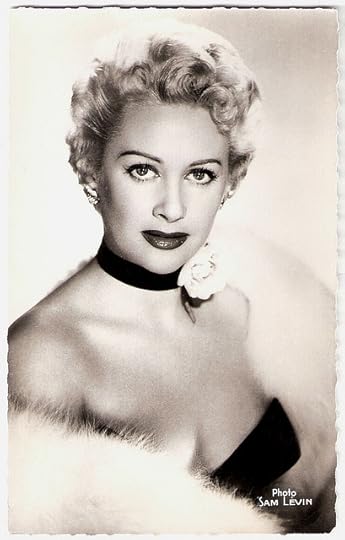
French postcard by Edition du Globe (EDUG), Paris, no. 320. Photo: Sam Lévin.
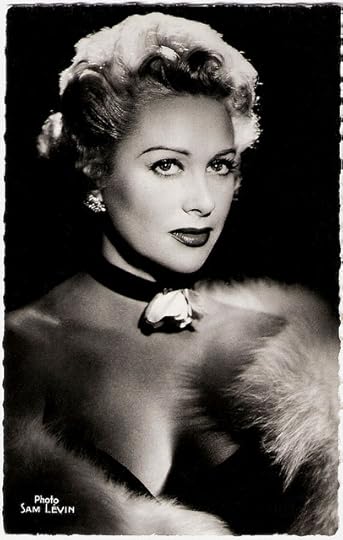
French postcard by Edition du Globe (EDUG), Paris, no. 321. Photo: Sam Lévin.
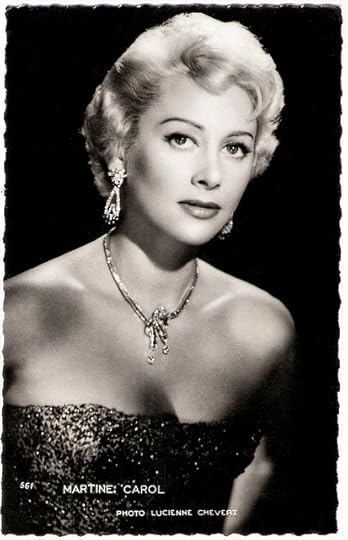
French postcard, no. 651. Photo: Lucienne Chevert.

German postcard by ISV, no. D 9. Photo: Farabola.
Sources: (IMDb), Wikipedia, and .

Yugoslavian postcard by Studio Sombor, no. 314.

French postcard by Editions du Globe (E.D.U.G.), Paris, no. 132. Photo: Sam Lévin.

French postcard by Editions P.I., no. 210 H. Photo: Lucienne Chevert, no. 456.

French postcard by Editions du Globe, Paris, no. 690. Photo: Sam Lévin.

Vintage card. Photo: still for Lucrèce Borgia/Lucretia Borgia (Christian-Jaque, 1953).
Anti-Semitic Propaganda
Martine Carol was born in 1920 as Maryse Louise Mourer in Saint-Mandé, Val-de-Marne, France.
A chance meeting with comedian André Luguet steered her toward a career in the theatre. Trained by René Simon, she made her 1940 stage debut with Phèdre, billed as Maryse Arley.
She subsequently caught the eye of film director Henri-Georges Clouzot who hired her for his film Le Chat/The Cat, based on the novel by Colette, but the project was scrapped.
She made her first film appearance in the anti-Semitic propaganda film Les Corrupteurs (Pierre Ramelot, 1941), but she first attracted attention in La ferme aux loups/Wolf Farm (Richard Pottier, 1943), which takes advantage of her photogenic beauty and ease in front of the camera despite a limited acting ability.
Throughout the 1940s she was a pin-up goddess and support actress in films like the comedy Voyage surprise (Pierre Prévert, 1947) and Les amants de Vérone/The Lovers of Verona (André Cayatte, 1949).
She also appeared on the stage of the Theatre of the Renaissance. In 1947 a torrid affair with actor Georges Marchal , who was married to actress Dany Robin at the time, ended disastrously and she attempted suicide by taking an alcohol/drug overdose and throwing herself off a bridge into the Seine River. She was saved by a taxi driver who accompanied her there. Ironically, the unhappy details surrounding her suicide attempt renewed the fascination audiences had with Martine up until that time.
She was also kidnapped by gangster Pierre Loutrel (aka ‘Crazy Pete’), albeit briefly and received roses the next day as an apology.

French postcard by Editions du Globe (E.D.U.G.), Paris, no. 357. Photo: Lucienne Chevert.

French postcard by Editions P.I., Paris, no. 364. Photo: Lucienne Chevert.

French postcard by Editions du Globe (E.D.U.G.), Paris, no. 564. Photo: Sam Lévin.

Dutch postcard by DRC, no. F192-657, posted in 1958.

German postcard by Kunst un Bild. Berlin, no. A 1146. Photo: Allianz-Film. Publicity still for Madame du Barry/Madame Dubarry (Christian Jacque, 1954).

French postcard by Editions du Globe, Paris, no. 432. Photo: Sam Lévin.
Taunting, Kittenish Sexuality
In 1950 Martine Carol scored her first huge film success with the French Revolution epic Caroline Cherie/Dear Caroline (Richard Pottier, 1950) - no doubt prompted by her semi-nude scenes and taunting, kittenish sexuality - and she was off and running at the box office.
Her film romps were typically done tastefully with an erotic twinge of innocence and gentle sexuality plus an occasional bubble bath thrown in as male bait. She continued spectacularly with an array of costumed teasers such as Adorables créatures/Adorable Creatures (1952), Lucrèce Borgia/Sins of the Borgias (1953), Madame du Barry (1954), and Nana (1954), all guided and directed by second husband Christian-Jacque, whom she married in 1954.
Martine later divorced the director due to professional conflicts and long separations. She also starred in Belles de Nuit/ Beauties of the Night (René Clair, 1952) opposite Gérard Philipe , and in the last comedy directed by Preston Sturges, Les Carnets du Major Thompson/The Diary of Major Thompson (1955), based on the best-seller by Pierre Daninos.
One of her last major roles was as the title character in Lola Montés (Max Ophüls, 1955), the tragic and true story of the great adventurer, circus attraction and lover of various important men.

German postcard by Universum-Film Aktiengesellschaft, Berlin-Tempelhof, no. CK-2. Retail price: 30 Pfg. Photo: Gérard Décaux/Ufa.

Dutch postcard by Gebr. Spanjersberg N.V., Rotterdam (Dutch licency holder for Ufa/Film-Foto, Berlin-Tempelhof), no. 3611. Photo: Sam Lévin / Unifrance Film.

German postcard by Ufa, Berlin-Tempelhof, no. FK 4064. Retail price: 25 Pfg. Photo: Ufa. Publicity still for The Stowaway (Ralph Habib, Lee Robinson, 1958).

German postcard by Kolibri-Verlag G.m.b.H. Minden/Westf., no. 1719. Photo: Gamma / Union / Vogelmann. Publicity still for Lola Montez (Max Ophüls, 1955) with Ivan Desny .

German postcard by Kolibri-Verlag, Minden-Westf., no. 1723. Photo: Gamma / Union / Vogelmann. Publicity still for Lola Montès (Max Ophüls, 1955).

German postcard by WS-Druck, Wanne-Eickel, no. F 5. Photo: Collignon.
Severe Decline
By the mid 1950s, Brigitte Bardot had replaced Martine Carol as the national Sex Siren, and the voluptuous blonde's career went into a severe decline.
Although such mature roles as Empress Josephine in Austerlitz/The Battle of Austerlitz (Abel Gance, 1960) and Contessa Vitelleschi in Vanina Vanini (Roberto Rossellini, 1961) followed, nothing revived audience interest.
Depressed, she turned alarmingly reclusive while a third marriage to French doctor Andre Rouveix also soured by 1962. Problems with substance abuse and a severe accident in the 1960s also curtailed her career dramatically.
Her last film was Hell Is Empty (John Ainsworth, Bernard Knowles, 1963). Production was briefly halted due to her illness. This is why the film has two directors. Although filmed in 1963 it was not released until 1967. (By the time of the release of the film, two of the leading ladies, Patricia Viterbo and Martine, were already dead.)
Martine Carol’s last marriage to fourth husband Mike Eland, an English businessman and friend of first husband Steve Crane, seemed hopeful, but in 1967, she died of cardiac arrest at age 46 in the bathroom of a hotel in Monaco. Her husband discovered her.
Newspapers hinted at a possible drug overdose but nothing was ever proven. She was initially buried in the Père Lachaise Cemetery of Paris. But her grave was violated (some media reported that she had been interred with her jewels). Martine Carol was then buried in the Grand Jas Cemetery of Cannes.

German postcard by Ufa, Berlin-Tempelhof, no.58. Retail price: 50 Pfg. Photo: G.B. Poletto / Ufa.

French postcard by Edition du Globe (EDUG), Paris, no. 320. Photo: Sam Lévin.

French postcard by Edition du Globe (EDUG), Paris, no. 321. Photo: Sam Lévin.

French postcard, no. 651. Photo: Lucienne Chevert.

German postcard by ISV, no. D 9. Photo: Farabola.
Sources: (IMDb), Wikipedia, and .
Published on February 13, 2014 23:00
February 12, 2014
Arne Molander
European Film Star Postcards presents the stars of the European cinema, but also lesser known actors whose postcards have survived. The texts in this blog we mainly base on the information about these actors on the net. A curious and fascinating case is Arne Molander. We found three Ross Verlag postcards of this forgotten actor, but there is nearly no trace of him on the net. Who was he - or she?
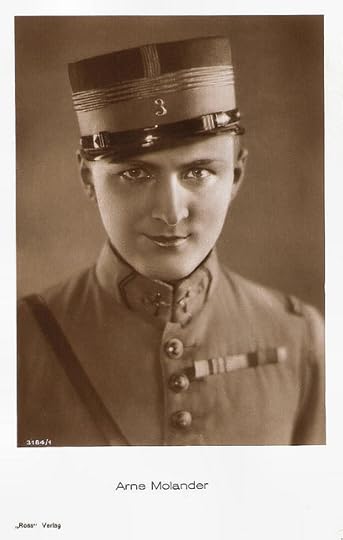
German Postcard by Ross Verlag, no. 3184/1, 1928-1929.
Red Baron
According to IMDb, Arne Molander appeared in two films, but gives no further information about the actor.
He had a leading part in the war drama Richthofen, der Rote Ritter der Luft/Richthofen (Peter Joseph, Desider Kertesz, 1927-1929) as the son of the famous German Baron and WW I hero, played by Georg Burghardt.
The three Ross Verlag postcards, which were all published in the period 1927-1929, probably were intended to help promote this film.
At Spiegelonline , Ralf Bülow writes that the film that started a complete new genre: "Richthofen was not dead for ten years, when in November 1927 the Dresden actor Carl Walther Meyer started to produce Richthofen, der Rote Ritter der Luft/Richthofen. The film was a mix of a love story and a spy story in which the hero only played a supporting part. The budget reached just for a single flight-capable Dreidecker, and apart from that the film makers helped themselves with film footage from the war archives.
At that time Richthofen ran successfully in cinemas in the Berlin suburbs and in the provinces. Today the film seems to be lost; only the library of the University of Texas has some scenes in their archives." (Translated from German by EFSP).
When the film was shown in the US in 1929, The New York Times wrote: "A carelessly assembled picture is the purported story of the German war ace, Richthofen, in which a love interest has been introduced. At least three-fourths of the film is devoted to an innocuously romantic tale having nothing whatever to do with "the Red Knight," relating as it does an affair of one of his friends. Several disturbing elements enter when daylight and night-time views are mixed indiscriminately. There are several interesting airplane combats. The photography for the most part is deplorable. Egon v. Jordon [Egon von Jordan] as Werner Dewall, Richthofen's friend, comes nearest to giving a performance. The rest is negligible."
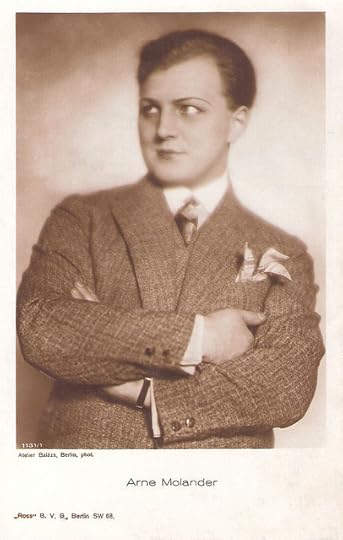
German Postcard by Ross Verlag, Berlin, no. 1131/1, 1927-1928. Photo: Atelier Balász, Berlin.
Viktor und Viktoria?
Richthofen did not stimulate Arne Molander's film career.
In the sound era, he played two small film parts, more than five years after his debut. IMDb only mentions one of the films, Der höhere Befehl/The Higher Command (Gerhard Lamprecht, 1935) starring Lil Dagover .
Filmportal.de adds the musical drama Schlussakkord/Final Accord (1936, Detlev Sierck a.k.a. Douglas Sirk, 1936) starring Lil Dagover again and Willy Birgel .
There is not further information about Arne Molander on the internet. Who was he? And what ever happened to him?
SpiegelonLine reproduced in their article the postcard above and adds that Molander was a Swedish actor, but there is no other source which confirms this.
Or was the mysterious Arne Molander in fact a she? Was Arne a real life version of the famous cross dressing comedy Viktor und Viktoria/Victor and Victoria ( Reinhold Schünzel , 1933)? Can he have been a real-life drag king who fooled everybody?
I intend to thinks so watching Arne's pictures, the form of his face and the heavy make-up. But it's only a wild guess.
What do you think about Arne? Do you have more information that can put more light on this mysterious actor? Please, share your comments.
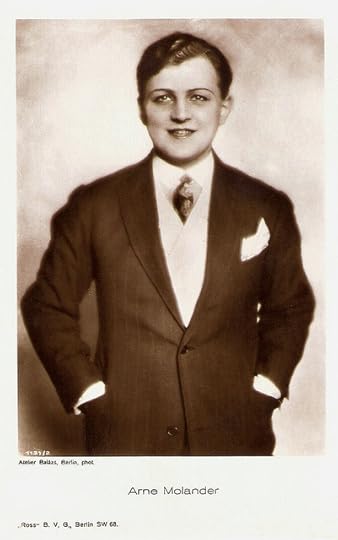
German Postcard by Ross Verlag, Berlin, no. 1131/2, 1927-1928. Photo: Atelier Balász, Berlin.
Sources: Ralf Bülow (Spiegelonline), New York Times, Filmportal.de and .

German Postcard by Ross Verlag, no. 3184/1, 1928-1929.
Red Baron
According to IMDb, Arne Molander appeared in two films, but gives no further information about the actor.
He had a leading part in the war drama Richthofen, der Rote Ritter der Luft/Richthofen (Peter Joseph, Desider Kertesz, 1927-1929) as the son of the famous German Baron and WW I hero, played by Georg Burghardt.
The three Ross Verlag postcards, which were all published in the period 1927-1929, probably were intended to help promote this film.
At Spiegelonline , Ralf Bülow writes that the film that started a complete new genre: "Richthofen was not dead for ten years, when in November 1927 the Dresden actor Carl Walther Meyer started to produce Richthofen, der Rote Ritter der Luft/Richthofen. The film was a mix of a love story and a spy story in which the hero only played a supporting part. The budget reached just for a single flight-capable Dreidecker, and apart from that the film makers helped themselves with film footage from the war archives.
At that time Richthofen ran successfully in cinemas in the Berlin suburbs and in the provinces. Today the film seems to be lost; only the library of the University of Texas has some scenes in their archives." (Translated from German by EFSP).
When the film was shown in the US in 1929, The New York Times wrote: "A carelessly assembled picture is the purported story of the German war ace, Richthofen, in which a love interest has been introduced. At least three-fourths of the film is devoted to an innocuously romantic tale having nothing whatever to do with "the Red Knight," relating as it does an affair of one of his friends. Several disturbing elements enter when daylight and night-time views are mixed indiscriminately. There are several interesting airplane combats. The photography for the most part is deplorable. Egon v. Jordon [Egon von Jordan] as Werner Dewall, Richthofen's friend, comes nearest to giving a performance. The rest is negligible."

German Postcard by Ross Verlag, Berlin, no. 1131/1, 1927-1928. Photo: Atelier Balász, Berlin.
Viktor und Viktoria?
Richthofen did not stimulate Arne Molander's film career.
In the sound era, he played two small film parts, more than five years after his debut. IMDb only mentions one of the films, Der höhere Befehl/The Higher Command (Gerhard Lamprecht, 1935) starring Lil Dagover .
Filmportal.de adds the musical drama Schlussakkord/Final Accord (1936, Detlev Sierck a.k.a. Douglas Sirk, 1936) starring Lil Dagover again and Willy Birgel .
There is not further information about Arne Molander on the internet. Who was he? And what ever happened to him?
SpiegelonLine reproduced in their article the postcard above and adds that Molander was a Swedish actor, but there is no other source which confirms this.
Or was the mysterious Arne Molander in fact a she? Was Arne a real life version of the famous cross dressing comedy Viktor und Viktoria/Victor and Victoria ( Reinhold Schünzel , 1933)? Can he have been a real-life drag king who fooled everybody?
I intend to thinks so watching Arne's pictures, the form of his face and the heavy make-up. But it's only a wild guess.
What do you think about Arne? Do you have more information that can put more light on this mysterious actor? Please, share your comments.

German Postcard by Ross Verlag, Berlin, no. 1131/2, 1927-1928. Photo: Atelier Balász, Berlin.
Sources: Ralf Bülow (Spiegelonline), New York Times, Filmportal.de and .
Published on February 12, 2014 23:00
Evelyn Laye
Evelyn Laye (1900–1996) was one of England's most popular stars of musical revue and operetta during the 1920s. She did a few screen appearances in both London and Hollywood, including in the classic musical Evensong (1934).
Belgian postcard by S.A. Cacoa et Chocolat Kivou, Vilvoorde. Photo: Artistes Associès.
British postcard by A Real Photograph, no. 25 3151/2. Caption: "A Joyous Birthday. May this birthday bring along, Every joy for which you long."
British postcard by De Reszke Cigarettes, no. 21. Photo: Gaumont-British.
Going Up
Elsie Evelyn Lay was born in Bloomsbury, London, in 1900. Her parents, Gilbert Laye and Evelyn Stewart, were both actors and Evelyn was already treading the boards at the age of two.
Her father managed the Palace Theatre in Brighton and this was where Evelyn first made a name for herself as Chinese servant Nang-Ping in Mr. Wu in 1915. Her London stage debut followed in 1916 in the revue Honi Soit at the East Ham Palace in 1916.
The first few years of her career she mainly played in musical comedy and operetta, including the aviation musical Going Up (1918-1919). She had her first West End success in 1920 with The Shop Girl, in which she was backed by a chorus of real guardsmen as she sang The Guards’ Parade.
Among her other successes during the 1920s were Phi-Phi (1922), Madame Pompadour (1923) - her first show for C.B. Cochran, Betty in Mayfair (1925-1926), Merely Molly (1926-1927), Blue Eyes (1928) and Lilac Time. Cochran called her ‘the fairest prima donna this side of heaven’.
In the cinema she made her debut in the British comedy thriller The Luck of the Navy (Fred Paul, 1927).
She married the comedian Sonnie Hale in 1926. Laye received widespread public sympathy when Hale left her for the actress Jessie Matthews in 1928. She subsequently wed actor Frank Lawton in 1934, with whom she remained married until his death in 1969.
In 1929, Evelyn Laye made her Broadway debut in the American première of Noël Coward's Bitter Sweet. Her song I'll See you Again became her trademark signature piece.
Her performance attracted the attention of film producer Samuel Goldwyn, who promptly brought her to Hollywood. She appeared in such early Hollywood film musicals as One Heavenly Night (George Fitzmaurice, 1931).
I.S. Mowis at IMDb : “The ridiculously contrived story and silly dialogue made this one of the worst flops of 1931, not helped by the wooden performance of Laye's co-star, John Boles. Although New York Times critic Mordaunt Hall, in his review reserved sole praise for Laye's singing and performance, Goldwyn washed his hands of the whole affair and Evelyn returned to England.”
British card.
British Raphael Tuck & Sons' Real Photograph postcard, no. 72. Photo: Gaumont-British.
Princess Charming
Back in London, Evelyn Laye continued acting in pantomimes such as The Sleeping Beauty and Cinderella. She also appeared to great acclaim in the British film musicals Waltz Time (Wilhelm Thiele, 1933) co-starring Fritz Schulz , Princess Charming (Maurice Elvey, 1934) and Evensong (Victor Saville, 1934) with Fritz Kortner .
She did another film in Hollywood, the film operetta The Night Is Young (Dudley Murphy, 1935), with Ramon Novarro. But again without success.
During the second half of the 1930s, Laye was a ‘ravishing’ Helen of Troy in Helen!, appeared with the young John Mills in Give Me A Ring, co-starred with Viennese tenor Richard Tauber in Paganini, and returned to Broadway in 1937 with Jack Buchanan and Adele Dixon for Between The Devil. The show made history when it was presented for one night at the National Theatre in New York on the occasion of President Roosevelt’s birthday, thereby becoming the first American Command Performance.
She spent most of the war years as entertainments director of the Royal Navy, performing frequently for the troops. After the Second World War, she had less success, but in 1954, she returned to the West End in the musical Wedding in Paris.
She also acted several times opposite husband Frank Lawton, including in the TV sitcom My Husband and I (1956). Other stage successes included Silver Wedding (1957) with Lawton, The Amorous Prawn (1959) and Phil the Fluter (1969).
Later films include the horror film Theatre of Death (Samuel Gallu, 1967) starring Christopher Lee, the drama Say Hello to Yesterday (Alvin Rakoff 1970) as the mother of Jean Simmons, and the unsuccessful drama Never Never Land (Paul Annett, 1980) starring Petula Clark . She also did a good deal of television work.
Laye was awarded a CBE (Commander of the Order of the British Empire) in 1973 for her services to drama. One of her last plays was Noel Coward's Semi-Monde (1987-1988), at the Royalty Theatre in London, with fellow cast members Kenneth Branagh and Judi Dench.
At the age of 92, she made her farewell tour of Britain with the nostalgia show Glamorous Nights At Drury Lane, and received standing ovations. Later that year, she was paid a tribute at the London Palladium, led by actor John Mills
Evelyn Laye died in a nursing home in Pimlico, Central London from respiratory failure in 1996. She was 95.
British postcard in the Picturegoer Series, London, no. 871. Photo: Gaumont-British.
British Real Photograph postcard, no. 83. Photo: Metro-Goldwyn-Mayer.
Sources: (IMDb), AllMusic, Wikipedia, and .
Belgian postcard by S.A. Cacoa et Chocolat Kivou, Vilvoorde. Photo: Artistes Associès.
British postcard by A Real Photograph, no. 25 3151/2. Caption: "A Joyous Birthday. May this birthday bring along, Every joy for which you long."
British postcard by De Reszke Cigarettes, no. 21. Photo: Gaumont-British.
Going Up
Elsie Evelyn Lay was born in Bloomsbury, London, in 1900. Her parents, Gilbert Laye and Evelyn Stewart, were both actors and Evelyn was already treading the boards at the age of two.
Her father managed the Palace Theatre in Brighton and this was where Evelyn first made a name for herself as Chinese servant Nang-Ping in Mr. Wu in 1915. Her London stage debut followed in 1916 in the revue Honi Soit at the East Ham Palace in 1916.
The first few years of her career she mainly played in musical comedy and operetta, including the aviation musical Going Up (1918-1919). She had her first West End success in 1920 with The Shop Girl, in which she was backed by a chorus of real guardsmen as she sang The Guards’ Parade.
Among her other successes during the 1920s were Phi-Phi (1922), Madame Pompadour (1923) - her first show for C.B. Cochran, Betty in Mayfair (1925-1926), Merely Molly (1926-1927), Blue Eyes (1928) and Lilac Time. Cochran called her ‘the fairest prima donna this side of heaven’.
In the cinema she made her debut in the British comedy thriller The Luck of the Navy (Fred Paul, 1927).
She married the comedian Sonnie Hale in 1926. Laye received widespread public sympathy when Hale left her for the actress Jessie Matthews in 1928. She subsequently wed actor Frank Lawton in 1934, with whom she remained married until his death in 1969.
In 1929, Evelyn Laye made her Broadway debut in the American première of Noël Coward's Bitter Sweet. Her song I'll See you Again became her trademark signature piece.
Her performance attracted the attention of film producer Samuel Goldwyn, who promptly brought her to Hollywood. She appeared in such early Hollywood film musicals as One Heavenly Night (George Fitzmaurice, 1931).
I.S. Mowis at IMDb : “The ridiculously contrived story and silly dialogue made this one of the worst flops of 1931, not helped by the wooden performance of Laye's co-star, John Boles. Although New York Times critic Mordaunt Hall, in his review reserved sole praise for Laye's singing and performance, Goldwyn washed his hands of the whole affair and Evelyn returned to England.”
British card.
British Raphael Tuck & Sons' Real Photograph postcard, no. 72. Photo: Gaumont-British.
Princess Charming
Back in London, Evelyn Laye continued acting in pantomimes such as The Sleeping Beauty and Cinderella. She also appeared to great acclaim in the British film musicals Waltz Time (Wilhelm Thiele, 1933) co-starring Fritz Schulz , Princess Charming (Maurice Elvey, 1934) and Evensong (Victor Saville, 1934) with Fritz Kortner .
She did another film in Hollywood, the film operetta The Night Is Young (Dudley Murphy, 1935), with Ramon Novarro. But again without success.
During the second half of the 1930s, Laye was a ‘ravishing’ Helen of Troy in Helen!, appeared with the young John Mills in Give Me A Ring, co-starred with Viennese tenor Richard Tauber in Paganini, and returned to Broadway in 1937 with Jack Buchanan and Adele Dixon for Between The Devil. The show made history when it was presented for one night at the National Theatre in New York on the occasion of President Roosevelt’s birthday, thereby becoming the first American Command Performance.
She spent most of the war years as entertainments director of the Royal Navy, performing frequently for the troops. After the Second World War, she had less success, but in 1954, she returned to the West End in the musical Wedding in Paris.
She also acted several times opposite husband Frank Lawton, including in the TV sitcom My Husband and I (1956). Other stage successes included Silver Wedding (1957) with Lawton, The Amorous Prawn (1959) and Phil the Fluter (1969).
Later films include the horror film Theatre of Death (Samuel Gallu, 1967) starring Christopher Lee, the drama Say Hello to Yesterday (Alvin Rakoff 1970) as the mother of Jean Simmons, and the unsuccessful drama Never Never Land (Paul Annett, 1980) starring Petula Clark . She also did a good deal of television work.
Laye was awarded a CBE (Commander of the Order of the British Empire) in 1973 for her services to drama. One of her last plays was Noel Coward's Semi-Monde (1987-1988), at the Royalty Theatre in London, with fellow cast members Kenneth Branagh and Judi Dench.
At the age of 92, she made her farewell tour of Britain with the nostalgia show Glamorous Nights At Drury Lane, and received standing ovations. Later that year, she was paid a tribute at the London Palladium, led by actor John Mills
Evelyn Laye died in a nursing home in Pimlico, Central London from respiratory failure in 1996. She was 95.
British postcard in the Picturegoer Series, London, no. 871. Photo: Gaumont-British.
British Real Photograph postcard, no. 83. Photo: Metro-Goldwyn-Mayer.
Sources: (IMDb), AllMusic, Wikipedia, and .
Published on February 12, 2014 23:00
February 11, 2014
Ria Jende
German-Belgian actress Ria Jende (1898-?) was a star and producer of the silent German cinema. She appeared in 40 films, before she married and retired.

German postcard by Photochemie, Berlin, no. K.3239. Photo: Alex Binder.
German postcard by Ross Verlag, Berlin, no. 264/1, 1919-1924. Photo: Alex Binder.
A Magician’s Assistant
Ria Jende's life is largely hidden in the dark. We know that she was born in Brussels, Belgium, in 1898. As a young girl, she went from Belgium to Germany.
Before the First World War, Edison brought her before the camera in Das Stelldichein der Verehrer/The gathering of worshipers (Manfred Noa, 1912) and another film pioneer Oskar Messter followed with Problematische Naturen/Problematic natures (Hans Oberländer, 1912) with Erich Kaiser-Titz .
After her film debut, she worked in the theatre. For a while she was a magician’s assistant.
In 1917, Jende accepted another film offer by Messter-film and co-starred with Viggo Larsen in his Der graue Herr/The man in gray (Viggo Larsen, 1917). Then she co-starred with Bruno Kastner and Mia May in Ein Lichtstrahl im Dunkel/A beam of light in the darkness (Joe May, 1917).
For the next five years she appeared in several insignificant entertainment productions. These included Der Ring der drei Wünsche/The ring of three wishes (Arthur Wellin, 1918) with Alexander Moissi , Der Teufel/The Devil (Ewald André Dupont, 1918), and the mystery Die Japanerin/The Japanese Woman (Ewald André Dupont, (1919) with Bernhard Goetzke and Max Landa .
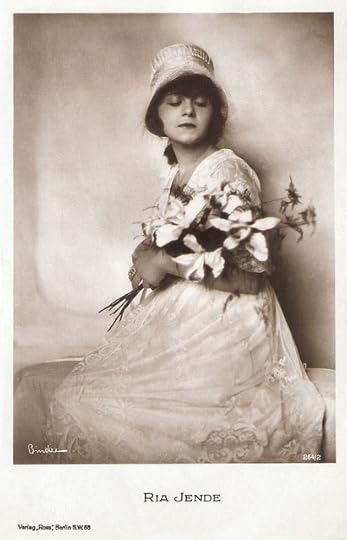
German postcard by Ross Verlag, Berlin, no. 264/2, 1919-1924. Photo: Alex Binder.

German postcard by Photochemie, Berlin, no. 3842. Photo: Alex Binder.

German postcard by Ross Verlag, Berlin, no. 1018/1, 1927-1928. Photo: Alex Binder.
Her Own Film Company
During the production of Nixchen (Paul Legband, 1919), starring Georg Alexander , Ria Jende met author and scriptwriter Franz W. Koebner, who became her husband.
In 1919 Jende started her own film company, Ria Jende Film. She produced Madeleine (Siegfried Philippi, 1921) with Hermann Valentin, and Versunkene Welten/Sunken Worlds (Siegfried Philippi, 1922) with Victor Varconi , but her company was short-lived.
As an actress she appeared in films like Die Schlange mit dem Mädchenkopf/The Serpent with the head of a girl (Rudolf Walther-Fein, 1920) opposite Hans Albers , Der Held des Tages/The hero of the day (Rudi Bach, 1921) and Das Geheimnis der Santa Margherita/The Secret of Santa Margherita (Rolf Randolf, 1921).
In 1922, Ria Jende married Franz W. Koebner, and thus ended her film career. Her final film was Das blinde Gluck/The blind luck (Iva Raffay, 1922).
After that she only once returned to the cinema, for a part in Die Abenteuer des Kapitän Hasswell/The Adventures of Captain Hate Well (Rolf Randolf, 1925) with Ernst Pittschau.
In 1926 Ria Jende published a travelogue of Malta in the Berlin magazine Das Magazin . Her husband also wrote for the same issue. Further data of her life are not known.
German postcard by Ross Verlag, Berlin, no. 295/2, 1919-1924. Photo: Alex Binder.

German postcard by Photochemie, Berlin, no. 3081. Photo: Greenbaum-Film. Publicity still for Seelenverkäufer/Seller of souls (Lupu Pick, 1919).
Sources: Thomas Staedeli (Cyranos), Filmportal.de, Wikipedia (German), and .

German postcard by Photochemie, Berlin, no. K.3239. Photo: Alex Binder.
German postcard by Ross Verlag, Berlin, no. 264/1, 1919-1924. Photo: Alex Binder.
A Magician’s Assistant
Ria Jende's life is largely hidden in the dark. We know that she was born in Brussels, Belgium, in 1898. As a young girl, she went from Belgium to Germany.
Before the First World War, Edison brought her before the camera in Das Stelldichein der Verehrer/The gathering of worshipers (Manfred Noa, 1912) and another film pioneer Oskar Messter followed with Problematische Naturen/Problematic natures (Hans Oberländer, 1912) with Erich Kaiser-Titz .
After her film debut, she worked in the theatre. For a while she was a magician’s assistant.
In 1917, Jende accepted another film offer by Messter-film and co-starred with Viggo Larsen in his Der graue Herr/The man in gray (Viggo Larsen, 1917). Then she co-starred with Bruno Kastner and Mia May in Ein Lichtstrahl im Dunkel/A beam of light in the darkness (Joe May, 1917).
For the next five years she appeared in several insignificant entertainment productions. These included Der Ring der drei Wünsche/The ring of three wishes (Arthur Wellin, 1918) with Alexander Moissi , Der Teufel/The Devil (Ewald André Dupont, 1918), and the mystery Die Japanerin/The Japanese Woman (Ewald André Dupont, (1919) with Bernhard Goetzke and Max Landa .

German postcard by Ross Verlag, Berlin, no. 264/2, 1919-1924. Photo: Alex Binder.

German postcard by Photochemie, Berlin, no. 3842. Photo: Alex Binder.

German postcard by Ross Verlag, Berlin, no. 1018/1, 1927-1928. Photo: Alex Binder.
Her Own Film Company
During the production of Nixchen (Paul Legband, 1919), starring Georg Alexander , Ria Jende met author and scriptwriter Franz W. Koebner, who became her husband.
In 1919 Jende started her own film company, Ria Jende Film. She produced Madeleine (Siegfried Philippi, 1921) with Hermann Valentin, and Versunkene Welten/Sunken Worlds (Siegfried Philippi, 1922) with Victor Varconi , but her company was short-lived.
As an actress she appeared in films like Die Schlange mit dem Mädchenkopf/The Serpent with the head of a girl (Rudolf Walther-Fein, 1920) opposite Hans Albers , Der Held des Tages/The hero of the day (Rudi Bach, 1921) and Das Geheimnis der Santa Margherita/The Secret of Santa Margherita (Rolf Randolf, 1921).
In 1922, Ria Jende married Franz W. Koebner, and thus ended her film career. Her final film was Das blinde Gluck/The blind luck (Iva Raffay, 1922).
After that she only once returned to the cinema, for a part in Die Abenteuer des Kapitän Hasswell/The Adventures of Captain Hate Well (Rolf Randolf, 1925) with Ernst Pittschau.
In 1926 Ria Jende published a travelogue of Malta in the Berlin magazine Das Magazin . Her husband also wrote for the same issue. Further data of her life are not known.
German postcard by Ross Verlag, Berlin, no. 295/2, 1919-1924. Photo: Alex Binder.

German postcard by Photochemie, Berlin, no. 3081. Photo: Greenbaum-Film. Publicity still for Seelenverkäufer/Seller of souls (Lupu Pick, 1919).
Sources: Thomas Staedeli (Cyranos), Filmportal.de, Wikipedia (German), and .
Published on February 11, 2014 23:00
February 10, 2014
Michel Auclair
French actor Michel Auclair (1922-1988) is best known for his roles in over 100 French films. He appeared in only a few English-language films.

French postcard by O.P., Paris. no. 77. Photo: Studio Harcourt.

French postcard by Editions du Globe, Paris, no. 225. Photo Studio Harcourt.
A Menacing but also Fragile Seducer
Michel Auclair was born Vladimir Vujović in Koblenz, Germany, in 1922. His father was Vojislav Vujović, a prominent Yugoslav Communist and a secretary of the Communist Youth International, and his mother was Charlotte Caspar, French biologist and sister of John Marchat.
Auclair moved to Paris when he was three years old. He later entered medical school but then studied acting at the Conservatoire (CNSAD) in Paris.
His stage debut was at the Théâtre de l'Œuvre in 1940 and he appeared in plays by Alfred de Musset, Jean Cocteau and Henrik Ibsen. His stage name was based on the title of a play by Charles Vildrac, which revolves around the loyalty of a man to a woman who has rejected him. It was written in the year of the actor's birth, 1921.
Auclair made his screen debut after the war in the classic La Belle et la Bête/Beauty and the Beast (Jean Cocteau, 1946). It was followed by a part in the war drama Les Maudits/The Damned (René Clément, 1946).
Two years later he starred in Manon (Henri-Georges Clouzot, 1949) as a French Resistance fighter who rescues a woman ( Cécile Aubry ) from villagers convinced she is a Nazi collaborator. The film won the Golden Lion at the Venice Film Festival.
In the following decade, he gradually developed into a leading man of the post-war French cinema. His type was the deprived dandy, a menacing but also fragile seducer.
His films included the German-French whodunit Unter den tausend Laternen/Under Thousand Lanterns (Erich Engel, 1952), the comedy La fête à Henriette/Holiday for Henrietta (Julien Duvivier, 1952) with Dany Robin , the historical epic Si Versailles m'était conté/Royal Affairs in Versailles (Sacha Guitry, 1954), the Georges Siménon adaptation Maigret et l'affaire Saint-Fiacre/Maigret and the St. Fiacre Case (Jean Delannoy, 1959) starring Jean Gabin , and L'Education Sentimentale/Sentimental Education (Alexandre Astruc, 1962) with Jean-Claude Brialy and Marie-José Nat .

French postcard by Editions P.I., Paris, no. 959 A. Publicity card for les Carbones Korès. Photo: Sam Lévin.

German postcard by Ufa (Universum-Film Aktien Gesellschaft), Berlin-Tempelhof, no. FK 1020. Retail price: 25 Pfg. Photo: Lucienne Chevert, Paris.

German postcard by WS-Druck, Wanne-Eickel, no. 124. Photo: Lantin.

French collectors card by Editions P.I. Paris for Biscottes Corvisart, Epinal.
Shady Film Producer
While a major French star, Michel Auclair only had a few English-language roles: as Professor Flostre in the musical Funny Face (Stanley Donen, 1957) with Audrey Hepburn and Fred Astaire, as a French police investigator in Day of the Jackal (Fred Zinnemann, 1973) with Edward Fox, as a cuckolded husband in Story of a Love Story (John Frankenheimer, 1973) with Alan Bates , and a doctor in the spy film Enigma (Jeannot Swarc, 1983) with Martin Sheen.
Auclair played in excellent European productions like the political thriller Le Juge Fayard Dit le Sheriff/Judge Fayard, Called the Sheriff (Yves Boisset, 1977) starring Patrick Dewaere , Trois Hommes à Abattre/Three Men to Kill (Jacques Deray, 1980) with Alain Delon , Mille Milliards de Dollars/A Thousand Billion Dollars (Henri Verneuil, 1982) another political thriller starring Patrick Dewaere , and the mysterious fantasy La Belle Captive/The Beautiful Prisoner (Alain Robbe-Grillet, 1983).
Michel Auclair was also a distinguished stage actor. On television he is remembered as Luis de Sant'angel in the mini-series Christopher Columbus (Alberto Lattuada, 1985) starring Gabriel Byrne.
Michel Auclair died by a cerebral haemorrhage in 1988, in Saint-Paul-en-Forêt, Var, France. He had appeared in over 100 films.
In Preuve D'Amour/Love Token (Miguel Courtois, 1988), Auclair played one of his last screen roles: a shady film producer. The feature is dedicated to him.

German postcard by Netter's Star Verlag, Berlin.

German postcard by Kolibri-Verlag. Co., München. Photo: Kurt Ulrich-Film / Constantin Film / Wesel. Michel Auclair in the WWII thriller Der Fuchs von Paris/The Fox of Paris (Paul May, 1957).

French postcard, no. 153.

East-German postcard by VEB Progress Film-Vertrieb, Berlin, no. 1428, 1961. Photo: Progress. Publicity still for Unter den Tausend Laternen/Under Thousand Lanterns (1952).
Sources: Hal Erickson (AllMovie), José L Bernabé Tronchoni (Find A Grave), Wikipedia, and .

French postcard by O.P., Paris. no. 77. Photo: Studio Harcourt.

French postcard by Editions du Globe, Paris, no. 225. Photo Studio Harcourt.
A Menacing but also Fragile Seducer
Michel Auclair was born Vladimir Vujović in Koblenz, Germany, in 1922. His father was Vojislav Vujović, a prominent Yugoslav Communist and a secretary of the Communist Youth International, and his mother was Charlotte Caspar, French biologist and sister of John Marchat.
Auclair moved to Paris when he was three years old. He later entered medical school but then studied acting at the Conservatoire (CNSAD) in Paris.
His stage debut was at the Théâtre de l'Œuvre in 1940 and he appeared in plays by Alfred de Musset, Jean Cocteau and Henrik Ibsen. His stage name was based on the title of a play by Charles Vildrac, which revolves around the loyalty of a man to a woman who has rejected him. It was written in the year of the actor's birth, 1921.
Auclair made his screen debut after the war in the classic La Belle et la Bête/Beauty and the Beast (Jean Cocteau, 1946). It was followed by a part in the war drama Les Maudits/The Damned (René Clément, 1946).
Two years later he starred in Manon (Henri-Georges Clouzot, 1949) as a French Resistance fighter who rescues a woman ( Cécile Aubry ) from villagers convinced she is a Nazi collaborator. The film won the Golden Lion at the Venice Film Festival.
In the following decade, he gradually developed into a leading man of the post-war French cinema. His type was the deprived dandy, a menacing but also fragile seducer.
His films included the German-French whodunit Unter den tausend Laternen/Under Thousand Lanterns (Erich Engel, 1952), the comedy La fête à Henriette/Holiday for Henrietta (Julien Duvivier, 1952) with Dany Robin , the historical epic Si Versailles m'était conté/Royal Affairs in Versailles (Sacha Guitry, 1954), the Georges Siménon adaptation Maigret et l'affaire Saint-Fiacre/Maigret and the St. Fiacre Case (Jean Delannoy, 1959) starring Jean Gabin , and L'Education Sentimentale/Sentimental Education (Alexandre Astruc, 1962) with Jean-Claude Brialy and Marie-José Nat .

French postcard by Editions P.I., Paris, no. 959 A. Publicity card for les Carbones Korès. Photo: Sam Lévin.

German postcard by Ufa (Universum-Film Aktien Gesellschaft), Berlin-Tempelhof, no. FK 1020. Retail price: 25 Pfg. Photo: Lucienne Chevert, Paris.

German postcard by WS-Druck, Wanne-Eickel, no. 124. Photo: Lantin.

French collectors card by Editions P.I. Paris for Biscottes Corvisart, Epinal.
Shady Film Producer
While a major French star, Michel Auclair only had a few English-language roles: as Professor Flostre in the musical Funny Face (Stanley Donen, 1957) with Audrey Hepburn and Fred Astaire, as a French police investigator in Day of the Jackal (Fred Zinnemann, 1973) with Edward Fox, as a cuckolded husband in Story of a Love Story (John Frankenheimer, 1973) with Alan Bates , and a doctor in the spy film Enigma (Jeannot Swarc, 1983) with Martin Sheen.
Auclair played in excellent European productions like the political thriller Le Juge Fayard Dit le Sheriff/Judge Fayard, Called the Sheriff (Yves Boisset, 1977) starring Patrick Dewaere , Trois Hommes à Abattre/Three Men to Kill (Jacques Deray, 1980) with Alain Delon , Mille Milliards de Dollars/A Thousand Billion Dollars (Henri Verneuil, 1982) another political thriller starring Patrick Dewaere , and the mysterious fantasy La Belle Captive/The Beautiful Prisoner (Alain Robbe-Grillet, 1983).
Michel Auclair was also a distinguished stage actor. On television he is remembered as Luis de Sant'angel in the mini-series Christopher Columbus (Alberto Lattuada, 1985) starring Gabriel Byrne.
Michel Auclair died by a cerebral haemorrhage in 1988, in Saint-Paul-en-Forêt, Var, France. He had appeared in over 100 films.
In Preuve D'Amour/Love Token (Miguel Courtois, 1988), Auclair played one of his last screen roles: a shady film producer. The feature is dedicated to him.

German postcard by Netter's Star Verlag, Berlin.

German postcard by Kolibri-Verlag. Co., München. Photo: Kurt Ulrich-Film / Constantin Film / Wesel. Michel Auclair in the WWII thriller Der Fuchs von Paris/The Fox of Paris (Paul May, 1957).

French postcard, no. 153.

East-German postcard by VEB Progress Film-Vertrieb, Berlin, no. 1428, 1961. Photo: Progress. Publicity still for Unter den Tausend Laternen/Under Thousand Lanterns (1952).
Sources: Hal Erickson (AllMovie), José L Bernabé Tronchoni (Find A Grave), Wikipedia, and .
Published on February 10, 2014 23:00
February 9, 2014
Elizabeth Allan
English actress Elizabeth Allan (1910-1990) worked in both Britain and Hollywood, making about 50 films over more than a quarter century.

British postcard by Milton, no. 109. Photo: Metro-Goldwyn-Mayer.
British postcard. Photo: Dorothy Wilding.
A Memorable Year in Hollywood
Elizabeth Allan was born at Skegness, Lincolnshire in 1910 (some sources indicate 1908). She was the youngest of six children born to Dr. Alexander William Allan and Amelia Allan.
Briefly, she worked as a kindergarten teacher before becoming an actress. After four years onstage with the Old Vic, she made her film debut in Alibi (Leslie S. Hiscott, 1931) based on the Agatha Christie novel The Murder of Roger Ackroyd and featuring for the first time her famous Belgian detective Hercule Poirot (Austin Trevor).
She also featured in Gainsborough's Michael and Mary (Victor Saville, 1931). This was the first of the Edna Best and Herbert Marshall co-starring talkies. It was based on a play of the same name by A.A. Milne.
In the comedy Service for Ladies (Alexander Korda, 1932) she co-starred with Leslie Howard . That year she also appeared in the British thriller The Lodger (Maurice Elvey, 1932) starring Ivor Novello . It is based on the novel The Lodger by Marie Belloc Lowndes, which was already filmed in 1927 in a silent version directed by Alfred Hitchcock and also starring Novello.
In 1932, she married agent Wilfred J. O'Bryen — to whom she had been introduced by actor Herbert Marshall . He took a major interest in her career and their marriage lasted until his death in 1977.
In 1933 came her first US production, the drama The Solitaire Man (Jack Conway, 1933), starring Herbert Marshall . In the United States, she worked under contract with MGM.
1935 was her most memorable year in Hollywood. She distinguished herself in two memorable Charles Dickens' adaptations, as David's unfortunate young mother in David Copperfield (George Cukor, 1935) and as Lucie Manette in A Tale of Two Cities (Jack Conway, 1935) starring Ronald Colman .
Allan was also featured in Tod Browning's Mark of the Vampire (1935) with Lionel Barrymore and Béla Lugosi .
The following year, she had a supporting part in the romantic drama Camille (George Cukor, 1936) starring Greta Garbo .
MGM announced her for a leading part in King Vidor's The Citadel (1938), and, when she was subsequently replaced by Rosalind Russell, Elizabeth sued the studio. The studio retaliated by refusing to let her work, and, frustrated, she returned to the UK in 1938.

With Ivor Novello. British postcard by A Real Photograph in the Film Partners series, no. P 41. Photo: Stanborough.

British postcard by Film Weekly Services, London.
Unofficial Propaganda For The War Effort
Back in England, Elizabeth Allan starred in the British crime film Inquest (Roy Boulting, 1939), the thriller Saloon Bar (Walter Forde, 1940) and the comedy The Girl Who Forgot (Adrian Brunel, 1940).
The British war film Went the Day Well? (Alberto Cavalcanti, 1942) was produced by Michael Balcon of Ealing Studios and served as unofficial propaganda for the war effort.
In the comedy He Snoops to Conquer (Marcel Varnel, 1944) she starred with George Formby.
By the 1950s, Elizabeth Allan had made the transition to character parts. She played a supporting part in the British disaster film No Highway in the Sky (Henry Koster, 1951), starring James Stewart and Marlene Dietrich .
Particularly memorable is her appearance as Trevor Howard 's brittle and dissatisfied wife in the film adaptation of Graham Greene's The Heart of the Matter (George More O'Ferrall, 1953).
In 1958, she appeared as Boris Karloff's wife in The Haunted Strangler (Robert Day, 1958).
Late in her career, she was a frequent panellist on television game shows, including the British version of What's My Line?. She was named Great Britain's Top Female TV Personality of 1952.
Elizabeth Allan died in 1990 at Hove, East Sussex, aged 80.

British postcard by Real Photograph in the Film Kurier Series, no. 125. Photo: Metro-Goldwyn-Mayer.
British postcard in the Picturegoer Series, London, no. 617. Photo: Stanborough.
Sources: Wikipedia and .

British postcard by Milton, no. 109. Photo: Metro-Goldwyn-Mayer.
British postcard. Photo: Dorothy Wilding.
A Memorable Year in Hollywood
Elizabeth Allan was born at Skegness, Lincolnshire in 1910 (some sources indicate 1908). She was the youngest of six children born to Dr. Alexander William Allan and Amelia Allan.
Briefly, she worked as a kindergarten teacher before becoming an actress. After four years onstage with the Old Vic, she made her film debut in Alibi (Leslie S. Hiscott, 1931) based on the Agatha Christie novel The Murder of Roger Ackroyd and featuring for the first time her famous Belgian detective Hercule Poirot (Austin Trevor).
She also featured in Gainsborough's Michael and Mary (Victor Saville, 1931). This was the first of the Edna Best and Herbert Marshall co-starring talkies. It was based on a play of the same name by A.A. Milne.
In the comedy Service for Ladies (Alexander Korda, 1932) she co-starred with Leslie Howard . That year she also appeared in the British thriller The Lodger (Maurice Elvey, 1932) starring Ivor Novello . It is based on the novel The Lodger by Marie Belloc Lowndes, which was already filmed in 1927 in a silent version directed by Alfred Hitchcock and also starring Novello.
In 1932, she married agent Wilfred J. O'Bryen — to whom she had been introduced by actor Herbert Marshall . He took a major interest in her career and their marriage lasted until his death in 1977.
In 1933 came her first US production, the drama The Solitaire Man (Jack Conway, 1933), starring Herbert Marshall . In the United States, she worked under contract with MGM.
1935 was her most memorable year in Hollywood. She distinguished herself in two memorable Charles Dickens' adaptations, as David's unfortunate young mother in David Copperfield (George Cukor, 1935) and as Lucie Manette in A Tale of Two Cities (Jack Conway, 1935) starring Ronald Colman .
Allan was also featured in Tod Browning's Mark of the Vampire (1935) with Lionel Barrymore and Béla Lugosi .
The following year, she had a supporting part in the romantic drama Camille (George Cukor, 1936) starring Greta Garbo .
MGM announced her for a leading part in King Vidor's The Citadel (1938), and, when she was subsequently replaced by Rosalind Russell, Elizabeth sued the studio. The studio retaliated by refusing to let her work, and, frustrated, she returned to the UK in 1938.

With Ivor Novello. British postcard by A Real Photograph in the Film Partners series, no. P 41. Photo: Stanborough.

British postcard by Film Weekly Services, London.
Unofficial Propaganda For The War Effort
Back in England, Elizabeth Allan starred in the British crime film Inquest (Roy Boulting, 1939), the thriller Saloon Bar (Walter Forde, 1940) and the comedy The Girl Who Forgot (Adrian Brunel, 1940).
The British war film Went the Day Well? (Alberto Cavalcanti, 1942) was produced by Michael Balcon of Ealing Studios and served as unofficial propaganda for the war effort.
In the comedy He Snoops to Conquer (Marcel Varnel, 1944) she starred with George Formby.
By the 1950s, Elizabeth Allan had made the transition to character parts. She played a supporting part in the British disaster film No Highway in the Sky (Henry Koster, 1951), starring James Stewart and Marlene Dietrich .
Particularly memorable is her appearance as Trevor Howard 's brittle and dissatisfied wife in the film adaptation of Graham Greene's The Heart of the Matter (George More O'Ferrall, 1953).
In 1958, she appeared as Boris Karloff's wife in The Haunted Strangler (Robert Day, 1958).
Late in her career, she was a frequent panellist on television game shows, including the British version of What's My Line?. She was named Great Britain's Top Female TV Personality of 1952.
Elizabeth Allan died in 1990 at Hove, East Sussex, aged 80.

British postcard by Real Photograph in the Film Kurier Series, no. 125. Photo: Metro-Goldwyn-Mayer.
British postcard in the Picturegoer Series, London, no. 617. Photo: Stanborough.
Sources: Wikipedia and .
Published on February 09, 2014 23:00
February 8, 2014
Leo Genn
Leo Genn (1905–1978) was a refined British stage and film actor - and barrister. Known for his relaxed charm and his deep black velvet voice, he also had success in Hollywood classics like Quo Vadis (1951) and Moby Dick (1956).

British postcard in the Picturegoer Series, London, no. W 528. Photo: 20th Century Fox.
Actor and Attorney
Leo John Genn was born in, London, England in 1905. He was the son of Woolfe (William) Genn, a jewellery salesman, and his wife Rachel Asserson.
Genn attended the City of London School and studied law at St Catharine's College, Cambridge, qualifying as a barrister in 1928. He ceased practicing as a lawyer soon after the Second World War.
Genn's stage debut was in A Marriage has been Disarranged (1930). Actor/manager Leon M. Lion engaged him simultaneously as an actor and attorney. In 1933 he appeared in Ballerina by Rodney Ackland.
In 1934-1936, Leo Genn was a member of the Old Vic Company where he appeared in many productions of William Shakespeare . He supplemented his early acting career by continuing to practice law.
Genn's first film role was as Shylock in the British production Immortal Gentleman (Widgey R. Newman, 1935), about the life of William Shakespeare featuring discussions with various friends along with scenes of his plays.
Douglas Fairbanks, Jr. hired Genn as a technical advisor on the film Accused (Raoul Walsh, 1936). He was subsequently given a small part as Prosecuting Counsel in the romantic drama on the strength of a "splendid voice and presence".
In 1937 he was Horatio in Tyrone Guthrie's stage production of Hamlet, with Laurence Olivier as Hamlet, in Elsinore, Denmark.
In the cinema, he spent 1937 playing film prosecutors and defence attorneys but in 1938 he nabbed a small Indian character role in producer Alexander Korda's The Drum (Zoltan Korda, 1938) starring Sabu, and he was the young man who danced with Eliza Doolittle (Wendy Hiller) at the duchess's ball in Pygmalion (Anthony Asquith, Leslie Howard , 1938), although he was uncredited.
In 1938, Genn also appeared in the theatrical hit, The Flashing Stream by Charles Langbridge Morgan, and Genn made his American debut in early 1939 in the play's successful run on Broadway.
His many other stage performances included Lillian Hellman's Another Part of the Forest, 12 Angry Men, The Devil's Advocate, W. Somerset Maugham's The Sacred Flame.

British postcard by L.D. Ltd., London in the Film Star Autograph Portrait Series, no. 72. Photo: J. Arthur Rank Organisation. Publicity still for Personal Affair (Anthony Pelissier, 1953).

Vintage postcard. Photo: MGM.
Quo Vadis
During World War II, Leo Genn served in the Royal Artillery, being made Lieutenant Colonel in 1943.
In 1944, the actor was given official leave to appear as the Constable of France in Olivier's film adaptation of William Shakespeare's play Henry V ( Laurence Olivier , 1944). It is widely considered the first Shakespeare film to be both artistically and commercially successful.
Genn was awarded the Croix de Guerre in 1945. He was part of the British unit that investigated war crimes at Belsen concentration camp and later was an assistant prosecutor at the trial for Belsen in Lüneburg, Germany.
In 1946 he returned to law practice, but not for long. Genn had a great theatrical triumph in the 1946 Broadway production of Lillian Hellman's Another Part of the Forest. His stage and screen career flourished afterwards in both the US and England.
On screen, he was seen in the British thriller Green for Danger (Sidney Gilliat, 1946) with Alastair Sim, and the American drama The Snake Pit (Anatole Litvak, 1948) starring Olivia De Havilland.
A highlight was his role as Nero’s counselor, the sardonic Gaius Petronius, in the MGM epic Quo Vadis (Mervyn LeRoy, 1951).
William McPeak at IMDb : “Genn's generous part as the ancient Roman satirist was filled with double meaning quips and understated sarcasm that Genn delivered with his poker face charm and subtle sidelong glances. He is so good that the audience hangs on his next sub-level dig with anticipation that partially eclipses the first rate histrionics of Peter Ustinov as a tongue-in-cheek deranged Nero. The level of Genn's performance was recognized with a Best Supporting Actor Oscar nomination.”

British postcard in the Picturegoer Series, London, no. W 695. Photo: 20th Century Fox.
During the 1950s, Leo Genn also appeared in some rather forgettable American films, such as Plymouth Adventure (Clarence Brown, 1952), and the comedy The Girls of Pleasure Island (Alvin Ganzer, F. Hugh Herbert, 1953).
He fared far better in the British film Personal Affair (Anthony Pelissier, 1953), starring opposite Gene Tierney. Then he appeared with Gregory Peck and Richard Basehart in Moby Dick (John Huston, 1956), the film adaptation of Herman Melville's novel Moby-Dick.
He also played Major Michael Pemberton in Rossellini's remarkable and largely forgotten war film Era Notte a Roma/Escape by Night (Roberto Rossellini, 1960) with Giovanna Ralli .
Genn was a governor of the Mermaid Theatre and trustee of the Yvonne Arnaud Theatre. He was also council member of the Arts Educational Trust. He was appointed Distinguished Visiting Professor of Theatre Arts, Pennsylvania State University, in 1968 and Visiting Professor of Drama, University of Utah, in 1969.
Among his later films were the British drama Connecting Rooms (Franklin Gollings, 1970) starring Bette Davis, the low-budget horror-thriller Die Screaming, Marianne (Pete Walker, 1971) featuring Susan George, and the British cold war spy thriller The Mackintosh Man (John Huston, 1973) with Paul Newman.
In 1978, Leo Genn died in London from pneumonia, complications of a heart attack. His internment was in France.
Since 1933, Genn was married to Marguerite van Praag, a casting director at Ealing Studios. They had no children.
Dvd trailer Quo Vadis (Mervyn LeRoy, 1951). Source: Ioana Barbu (YouTube).
Leader and scenes of Too hot to handle (Terence Young, 1960) with Jayne Mansfield . Source: CinemaSirens (YouTube).
Sources: (IMDb), Paul (Find A Grave), AllMovie, Wikipedia, and .

British postcard in the Picturegoer Series, London, no. W 528. Photo: 20th Century Fox.
Actor and Attorney
Leo John Genn was born in, London, England in 1905. He was the son of Woolfe (William) Genn, a jewellery salesman, and his wife Rachel Asserson.
Genn attended the City of London School and studied law at St Catharine's College, Cambridge, qualifying as a barrister in 1928. He ceased practicing as a lawyer soon after the Second World War.
Genn's stage debut was in A Marriage has been Disarranged (1930). Actor/manager Leon M. Lion engaged him simultaneously as an actor and attorney. In 1933 he appeared in Ballerina by Rodney Ackland.
In 1934-1936, Leo Genn was a member of the Old Vic Company where he appeared in many productions of William Shakespeare . He supplemented his early acting career by continuing to practice law.
Genn's first film role was as Shylock in the British production Immortal Gentleman (Widgey R. Newman, 1935), about the life of William Shakespeare featuring discussions with various friends along with scenes of his plays.
Douglas Fairbanks, Jr. hired Genn as a technical advisor on the film Accused (Raoul Walsh, 1936). He was subsequently given a small part as Prosecuting Counsel in the romantic drama on the strength of a "splendid voice and presence".
In 1937 he was Horatio in Tyrone Guthrie's stage production of Hamlet, with Laurence Olivier as Hamlet, in Elsinore, Denmark.
In the cinema, he spent 1937 playing film prosecutors and defence attorneys but in 1938 he nabbed a small Indian character role in producer Alexander Korda's The Drum (Zoltan Korda, 1938) starring Sabu, and he was the young man who danced with Eliza Doolittle (Wendy Hiller) at the duchess's ball in Pygmalion (Anthony Asquith, Leslie Howard , 1938), although he was uncredited.
In 1938, Genn also appeared in the theatrical hit, The Flashing Stream by Charles Langbridge Morgan, and Genn made his American debut in early 1939 in the play's successful run on Broadway.
His many other stage performances included Lillian Hellman's Another Part of the Forest, 12 Angry Men, The Devil's Advocate, W. Somerset Maugham's The Sacred Flame.

British postcard by L.D. Ltd., London in the Film Star Autograph Portrait Series, no. 72. Photo: J. Arthur Rank Organisation. Publicity still for Personal Affair (Anthony Pelissier, 1953).

Vintage postcard. Photo: MGM.
Quo Vadis
During World War II, Leo Genn served in the Royal Artillery, being made Lieutenant Colonel in 1943.
In 1944, the actor was given official leave to appear as the Constable of France in Olivier's film adaptation of William Shakespeare's play Henry V ( Laurence Olivier , 1944). It is widely considered the first Shakespeare film to be both artistically and commercially successful.
Genn was awarded the Croix de Guerre in 1945. He was part of the British unit that investigated war crimes at Belsen concentration camp and later was an assistant prosecutor at the trial for Belsen in Lüneburg, Germany.
In 1946 he returned to law practice, but not for long. Genn had a great theatrical triumph in the 1946 Broadway production of Lillian Hellman's Another Part of the Forest. His stage and screen career flourished afterwards in both the US and England.
On screen, he was seen in the British thriller Green for Danger (Sidney Gilliat, 1946) with Alastair Sim, and the American drama The Snake Pit (Anatole Litvak, 1948) starring Olivia De Havilland.
A highlight was his role as Nero’s counselor, the sardonic Gaius Petronius, in the MGM epic Quo Vadis (Mervyn LeRoy, 1951).
William McPeak at IMDb : “Genn's generous part as the ancient Roman satirist was filled with double meaning quips and understated sarcasm that Genn delivered with his poker face charm and subtle sidelong glances. He is so good that the audience hangs on his next sub-level dig with anticipation that partially eclipses the first rate histrionics of Peter Ustinov as a tongue-in-cheek deranged Nero. The level of Genn's performance was recognized with a Best Supporting Actor Oscar nomination.”

British postcard in the Picturegoer Series, London, no. W 695. Photo: 20th Century Fox.
During the 1950s, Leo Genn also appeared in some rather forgettable American films, such as Plymouth Adventure (Clarence Brown, 1952), and the comedy The Girls of Pleasure Island (Alvin Ganzer, F. Hugh Herbert, 1953).
He fared far better in the British film Personal Affair (Anthony Pelissier, 1953), starring opposite Gene Tierney. Then he appeared with Gregory Peck and Richard Basehart in Moby Dick (John Huston, 1956), the film adaptation of Herman Melville's novel Moby-Dick.
He also played Major Michael Pemberton in Rossellini's remarkable and largely forgotten war film Era Notte a Roma/Escape by Night (Roberto Rossellini, 1960) with Giovanna Ralli .
Genn was a governor of the Mermaid Theatre and trustee of the Yvonne Arnaud Theatre. He was also council member of the Arts Educational Trust. He was appointed Distinguished Visiting Professor of Theatre Arts, Pennsylvania State University, in 1968 and Visiting Professor of Drama, University of Utah, in 1969.
Among his later films were the British drama Connecting Rooms (Franklin Gollings, 1970) starring Bette Davis, the low-budget horror-thriller Die Screaming, Marianne (Pete Walker, 1971) featuring Susan George, and the British cold war spy thriller The Mackintosh Man (John Huston, 1973) with Paul Newman.
In 1978, Leo Genn died in London from pneumonia, complications of a heart attack. His internment was in France.
Since 1933, Genn was married to Marguerite van Praag, a casting director at Ealing Studios. They had no children.
Dvd trailer Quo Vadis (Mervyn LeRoy, 1951). Source: Ioana Barbu (YouTube).
Leader and scenes of Too hot to handle (Terence Young, 1960) with Jayne Mansfield . Source: CinemaSirens (YouTube).
Sources: (IMDb), Paul (Find A Grave), AllMovie, Wikipedia, and .
Published on February 08, 2014 23:00
Paul van Yperen's Blog
- Paul van Yperen's profile
- 13 followers
Paul van Yperen isn't a Goodreads Author
(yet),
but they
do have a blog,
so here are some recent posts imported from
their feed.



